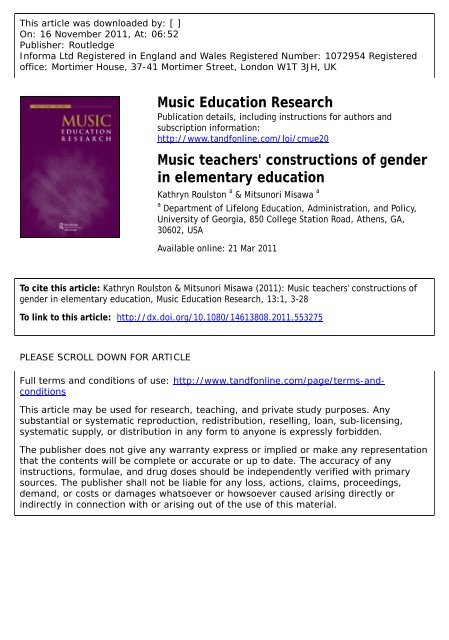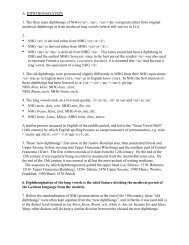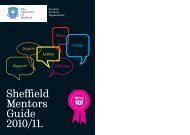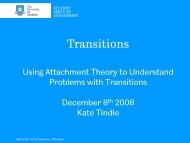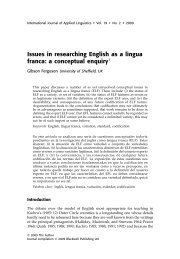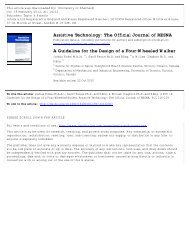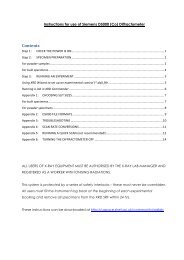Music teachers' constructions of gender in elementary education
Music teachers' constructions of gender in elementary education
Music teachers' constructions of gender in elementary education
You also want an ePaper? Increase the reach of your titles
YUMPU automatically turns print PDFs into web optimized ePapers that Google loves.
This article was downloaded by: [ ]<br />
On: 16 November 2011, At: 06:52<br />
Publisher: Routledge<br />
Informa Ltd Registered <strong>in</strong> England and Wales Registered Number: 1072954 Registered<br />
<strong>of</strong>fice: Mortimer House, 37-41 Mortimer Street, London W1T 3JH, UK<br />
<strong>Music</strong> Education Research<br />
Publication details, <strong>in</strong>clud<strong>in</strong>g <strong>in</strong>structions for authors and<br />
subscription <strong>in</strong>formation:<br />
http://www.tandfonl<strong>in</strong>e.com/loi/cmue20<br />
<strong>Music</strong> <strong>teachers'</strong> <strong>constructions</strong> <strong>of</strong> <strong>gender</strong><br />
<strong>in</strong> <strong>elementary</strong> <strong>education</strong><br />
Kathryn Roulston a & Mitsunori Misawa a<br />
a Department <strong>of</strong> Lifelong Education, Adm<strong>in</strong>istration, and Policy,<br />
University <strong>of</strong> Georgia, 850 College Station Road, Athens, GA,<br />
30602, USA<br />
Available onl<strong>in</strong>e: 21 Mar 2011<br />
To cite this article: Kathryn Roulston & Mitsunori Misawa (2011): <strong>Music</strong> <strong>teachers'</strong> <strong>constructions</strong> <strong>of</strong><br />
<strong>gender</strong> <strong>in</strong> <strong>elementary</strong> <strong>education</strong>, <strong>Music</strong> Education Research, 13:1, 3-28<br />
To l<strong>in</strong>k to this article: http://dx.doi.org/10.1080/14613808.2011.553275<br />
PLEASE SCROLL DOWN FOR ARTICLE<br />
Full terms and conditions <strong>of</strong> use: http://www.tandfonl<strong>in</strong>e.com/page/terms-andconditions<br />
This article may be used for research, teach<strong>in</strong>g, and private study purposes. Any<br />
substantial or systematic reproduction, redistribution, resell<strong>in</strong>g, loan, sub-licens<strong>in</strong>g,<br />
systematic supply, or distribution <strong>in</strong> any form to anyone is expressly forbidden.<br />
The publisher does not give any warranty express or implied or make any representation<br />
that the contents will be complete or accurate or up to date. The accuracy <strong>of</strong> any<br />
<strong>in</strong>structions, formulae, and drug doses should be <strong>in</strong>dependently verified with primary<br />
sources. The publisher shall not be liable for any loss, actions, claims, proceed<strong>in</strong>gs,<br />
demand, or costs or damages whatsoever or howsoever caused aris<strong>in</strong>g directly or<br />
<strong>in</strong>directly <strong>in</strong> connection with or aris<strong>in</strong>g out <strong>of</strong> the use <strong>of</strong> this material.
Downloaded by [ ] at 06:52 16 November 2011<br />
<strong>Music</strong> Education Research<br />
Vol. 13, No. 1, March 2011, 3 28<br />
<strong>Music</strong> teachers’ <strong>constructions</strong> <strong>of</strong> <strong>gender</strong> <strong>in</strong> <strong>elementary</strong> <strong>education</strong><br />
Kathryn Roulston* and Mitsunori Misawa<br />
Department <strong>of</strong> Lifelong Education, Adm<strong>in</strong>istration, and Policy, University <strong>of</strong> Georgia, 850<br />
College Station Road, Athens, GA 30602, USA<br />
(Received 24 February 2009; f<strong>in</strong>al version received 25 August 2010)<br />
In spite <strong>of</strong> a grow<strong>in</strong>g body <strong>of</strong> research <strong>in</strong> music <strong>education</strong> that focuses on a variety<br />
<strong>of</strong> <strong>gender</strong> issues, there is still limited <strong>in</strong>formation on music teachers’ experiences<br />
and <strong>constructions</strong> <strong>of</strong> their classroom practices <strong>in</strong> relation to their conceptualisations<br />
<strong>of</strong> <strong>gender</strong>. This paper exam<strong>in</strong>es music teachers’ descriptions <strong>of</strong> <strong>gender</strong> <strong>in</strong><br />
relation to their work as <strong>elementary</strong> music educators (5 10-year-olds). In an<br />
exploratory pilot study us<strong>in</strong>g a qualitative design, semi-structured 45 60 m<strong>in</strong>ute<br />
<strong>in</strong>terviews were conducted with one male and five female teachers. F<strong>in</strong>d<strong>in</strong>gs<br />
demonstrated that (1) teachers’ conceptualisation <strong>of</strong> the relevance <strong>of</strong> <strong>gender</strong> <strong>in</strong><br />
th<strong>in</strong>k<strong>in</strong>g about music teach<strong>in</strong>g varied considerably; (2) the role <strong>of</strong> the male<br />
teacher <strong>in</strong> the <strong>elementary</strong> school was described <strong>in</strong> significantly different ways to<br />
that <strong>of</strong> the role <strong>of</strong> female teacher; and (3) teachers commonly referenced teach<strong>in</strong>g<br />
strategies that re<strong>in</strong>force <strong>gender</strong> stereotypes. The study concludes by outl<strong>in</strong><strong>in</strong>g<br />
possible pathways for further research concern<strong>in</strong>g <strong>gender</strong> <strong>in</strong> relation to<br />
<strong>elementary</strong> music <strong>education</strong>.<br />
Keywords: <strong>elementary</strong> music; <strong>gender</strong><br />
Introduction<br />
Under the broad rubric <strong>of</strong> one <strong>of</strong> several suggested questions that might be asked <strong>in</strong><br />
music <strong>education</strong> research: ‘What are and should be the dimensions <strong>of</strong> music<br />
<strong>education</strong>?’ Noted music <strong>education</strong> researcher, Estelle Jorgensen (2008, 333) writes:<br />
In North America, at least, despite the <strong>in</strong>fluential work <strong>of</strong> writers who have advocated a<br />
humane approach to <strong>education</strong> and the redemptive claims <strong>of</strong> such values as justice,<br />
freedom, <strong>in</strong>clusiveness, and equality, music educators have yet to pay concerted<br />
attention to issues that have to do with race, <strong>gender</strong>, sexual identity, age, language,<br />
ethnicity, religion, colour, among a host <strong>of</strong> issues that constitute barriers between<br />
people.<br />
As Jorgensen comments, numerous scholars <strong>in</strong> social sciences have discussed race,<br />
class, <strong>gender</strong> and sexuality <strong>in</strong> relation to society and <strong>education</strong> (e.g. Newman 2007).<br />
Among these scholars, Critical Race theorists (Dixson and Rousseau 2005; Ladson-<br />
Bill<strong>in</strong>gs and Tate 1995; Lawrence et al. 1993) have proposed that racial dist<strong>in</strong>ctions<br />
have become blurred <strong>in</strong> the US society, a phenomenon that they call ‘colourbl<strong>in</strong>dness’.<br />
Similarly, by consider<strong>in</strong>g ‘<strong>gender</strong> problems’ as an artefact <strong>of</strong> the past<br />
that have been resolved, music educators may be at risk <strong>of</strong> succumb<strong>in</strong>g to<br />
*Correspond<strong>in</strong>g author. Email: roulston@uga.edu<br />
ISSN 1461-3808 pr<strong>in</strong>t/ISSN 1469-9893 onl<strong>in</strong>e<br />
# 2011 Taylor & Francis<br />
DOI: 10.1080/14613808.2011.553275<br />
http://www.<strong>in</strong>formaworld.com
Downloaded by [ ] at 06:52 16 November 2011<br />
4 K. Roulston and M. Misawa<br />
‘<strong>gender</strong>-bl<strong>in</strong>dness’, <strong>in</strong> which the view is taken that <strong>gender</strong> is no longer an issue<br />
worthy <strong>of</strong> further study. Yet, <strong>in</strong> the recently published The nation’s report card: Arts<br />
2008 <strong>Music</strong> and visual arts (Keiper et al. 2009), it is noted that by eighth grade, girls<br />
<strong>in</strong> the USA outperform boys <strong>in</strong> test scores <strong>in</strong> music. This identified <strong>gender</strong> gap<br />
<strong>in</strong>dicates that further research concern<strong>in</strong>g <strong>gender</strong> <strong>in</strong> music <strong>education</strong> is still<br />
warranted.<br />
Gender has long been the focus <strong>of</strong> a large body <strong>of</strong> research <strong>in</strong> <strong>education</strong> (see for<br />
example, Bailey 2002 for a review <strong>of</strong> topics). The impetus <strong>of</strong> much research has been<br />
to identify and improve structures with<strong>in</strong> school<strong>in</strong>g that have produced <strong>in</strong>equitable<br />
outcomes for boys and girls. For example, much work has exam<strong>in</strong>ed if and how boys<br />
and girls learn differently, and problems related to boys’ and girls’ <strong>education</strong>al<br />
opportunities (see Bailey 2002; Weaver-Hightower 2003 for examples). Research on<br />
<strong>gender</strong> has resulted <strong>in</strong> recommendations for how educators might accomplish<br />
equitable <strong>education</strong>al outcomes for girls and boys (for examples, see American<br />
Association <strong>of</strong> University Women [AAUW] 1998/2002; Kenway et al. 1997).<br />
In addition to research concern<strong>in</strong>g the <strong>education</strong> <strong>of</strong> boys and girls <strong>in</strong> schools, the<br />
lens <strong>of</strong> <strong>gender</strong> has also been used to exam<strong>in</strong>e teachers’ work, <strong>in</strong>clud<strong>in</strong>g women<br />
teachers <strong>in</strong> school<strong>in</strong>g (e.g. Acker 1989, 1992, 1994, 1995a, 1995b; Apple 1987; Biklen<br />
1995), <strong>education</strong>al change (e.g. Blackmore 1995, 1998, 1999), and the experiences <strong>of</strong><br />
male teachers work<strong>in</strong>g <strong>in</strong> fem<strong>in</strong>ised environments (e.g. Cooney and Bittner 2001;<br />
Francis 2007; Galley 2000; Montec<strong>in</strong>os and Nielsen 2004; Nelson 2002; Smedley<br />
2007; Sumsion 2000).<br />
Studies <strong>of</strong> <strong>gender</strong> issues by researchers <strong>in</strong> music <strong>education</strong> <strong>in</strong>clude quantitative<br />
<strong>in</strong>vestigations <strong>of</strong> the effects <strong>of</strong> <strong>gender</strong> on various aspects <strong>of</strong> musical performance<br />
such as students’ <strong>in</strong>strument choice and learn<strong>in</strong>g, s<strong>in</strong>g<strong>in</strong>g accuracy, musical<br />
preference and choral students’ perceptions <strong>of</strong> teacher feedback (e.g. Barry 1992;<br />
Cooper 1995; Delzell and Leppla 1992; Fortney, Boyle, and DeCarbo 1993;<br />
Hargreaves, Comber, and Colley 1995; Ho 2009; Schmidt 1995; Zervoudakes and<br />
Tanur 1994). One area <strong>of</strong> research has <strong>in</strong>vestigated how sexism and exclusionary<br />
practices towards women and girls are enacted with<strong>in</strong> music <strong>education</strong>. For example,<br />
Koza (1992, 1993, 1994) has conducted analyses <strong>of</strong> textbooks used <strong>in</strong> music<br />
<strong>education</strong>, and McWilliam (2005) has exam<strong>in</strong>ed the depiction <strong>of</strong> female w<strong>in</strong>d<br />
band conductors <strong>in</strong> The Instrumentalist Magaz<strong>in</strong>e. This k<strong>in</strong>d <strong>of</strong> work has shown the<br />
disproportional representation <strong>of</strong> men and women <strong>in</strong> music <strong>education</strong> texts, <strong>in</strong><br />
addition to unpack<strong>in</strong>g how representations <strong>of</strong> men and women <strong>in</strong> music differ. In<br />
other fem<strong>in</strong>ist research, Morton (1994) has exam<strong>in</strong>ed sexism <strong>in</strong> children’s song<br />
materials, and a number <strong>of</strong> researchers have drawn on fem<strong>in</strong>ist and post-structural<br />
theories to critique pedagogical and research practices <strong>in</strong> the field <strong>of</strong> music <strong>education</strong><br />
(Gould 1994, 2004; Lamb 1996, 1997; O’Toole 1994, 1997, 1998), draw<strong>in</strong>g some<br />
critique (e.g. Adler and Harrison 2004; Reimer 1995). Gender-related research<br />
<strong>in</strong>cludes the participation by boys <strong>in</strong> music programmes and strategies to encourage<br />
boys’ participation <strong>in</strong> music (Adler and Harrison 2004; Lamb, Doll<strong>of</strong>f, and Howe<br />
2002); and how children take up and reproduce ideologies associated with men’s and<br />
women’s musical practices with<strong>in</strong> music <strong>education</strong> (Charles 2004).<br />
Researchers have also exam<strong>in</strong>ed the experiences <strong>of</strong> men work<strong>in</strong>g <strong>in</strong> fem<strong>in</strong>ised<br />
environments, show<strong>in</strong>g that these men f<strong>in</strong>d themselves <strong>in</strong> the position <strong>of</strong> ‘other’ to<br />
women, with pressure to conform to hegemonic ideals <strong>of</strong> mascul<strong>in</strong>ity. Studies have<br />
shown that men who pursue careers <strong>in</strong> traditionally fem<strong>in</strong>ised work sett<strong>in</strong>gs, such as
Downloaded by [ ] at 06:52 16 November 2011<br />
<strong>Music</strong> Education Research 5<br />
early childhood, face numerous challenges such as isolation, suspicions surround<strong>in</strong>g<br />
their motivations to work with children, anxiety surround<strong>in</strong>g child-touch, and<br />
pressure to perform <strong>in</strong> stereotypically mascul<strong>in</strong>e roles. Male teachers <strong>in</strong> the US<br />
account for only 21% <strong>of</strong> the teach<strong>in</strong>g workforce, and male music teachers <strong>in</strong><br />
<strong>elementary</strong> school are even rarer. Male music teachers’ accounts <strong>of</strong> their work<br />
(Roulston and Mills 2000) suggest that for men who teach music especially <strong>in</strong><br />
<strong>elementary</strong> schools demands to conform to hegemonic notions <strong>of</strong> mascul<strong>in</strong>ity are<br />
amplified, s<strong>in</strong>ce the subject area <strong>of</strong> music occupies a subord<strong>in</strong>ate role with<strong>in</strong> school<br />
curriculums and historically has fem<strong>in</strong><strong>in</strong>e associations (Green 1997).<br />
There is still much to be learned about music teachers’ conceptualisations <strong>of</strong><br />
<strong>gender</strong> and how they account for these <strong>in</strong> relation to their classroom practices. This<br />
study <strong>in</strong>vestigated music teachers’ <strong>constructions</strong> <strong>of</strong> <strong>gender</strong> <strong>in</strong> relation to <strong>elementary</strong><br />
teach<strong>in</strong>g (<strong>in</strong> this study <strong>elementary</strong> refers to pre-K<strong>in</strong>dergarten to 5th grade <strong>in</strong>volv<strong>in</strong>g<br />
5 10-year-olds). Specifically we asked:<br />
(1) What are music teachers’ <strong>gender</strong>ed images <strong>of</strong> music teach<strong>in</strong>g?<br />
(2) In what ways do men and women describe their experiences <strong>of</strong> teach<strong>in</strong>g<br />
<strong>elementary</strong> music differently?<br />
Theoretical perspectives<br />
Connell (2002, 8) rejects the common usage <strong>of</strong> the term <strong>gender</strong> to mean ‘the cultural<br />
difference <strong>of</strong> women from men, based on the biological division between male and<br />
female’ as an adequate and appropriate def<strong>in</strong>ition. In this usage, <strong>gender</strong> is def<strong>in</strong>ed by<br />
‘dichotomy and difference’ (2002, 8). Instead, Connell (2002, 9) suggests that the<br />
focus <strong>of</strong> <strong>gender</strong> be on ‘relations’, highlight<strong>in</strong>g that <strong>gender</strong> is a ‘social structure ...<strong>of</strong> a<br />
particular k<strong>in</strong>d’. He expla<strong>in</strong>s:<br />
Gender <strong>in</strong>volves a specific relationship with bodies. This is recognized <strong>in</strong> the common<br />
sense def<strong>in</strong>ition <strong>of</strong> <strong>gender</strong> as an expression <strong>of</strong> natural difference, the bodily difference <strong>of</strong><br />
male from female. What is wrong with this formula is not the attention to bodies, nor<br />
the concern with sexual reproduction, but the idea that cultural patterns simply ‘express’<br />
bodily difference. (Connell 2002, 9)<br />
Here, Connell (2002) is challeng<strong>in</strong>g essentialist conceptualisations <strong>of</strong> <strong>gender</strong> <strong>in</strong> which<br />
fem<strong>in</strong><strong>in</strong>ity and mascul<strong>in</strong>ity are ‘largely biologically fixed’ <strong>in</strong> b<strong>in</strong>ary opposition to one<br />
other (Cushman 2008, 124). In order to ‘escape’ the ‘paradoxes <strong>of</strong> ‘‘difference’’’<br />
Connell proposes an alternative def<strong>in</strong>ition for the term <strong>gender</strong>, ‘Gender is the<br />
structure <strong>of</strong> social relations that centres on the reproductive arena, and the set <strong>of</strong><br />
practices (governed by this structure) that br<strong>in</strong>g reproductive dist<strong>in</strong>ctions between<br />
bodies <strong>in</strong>to social processes’ (2002, 10, italics <strong>in</strong> orig<strong>in</strong>al).<br />
In this paper Connell’s def<strong>in</strong>ition <strong>of</strong> <strong>gender</strong> is utilised to explore the social<br />
relations <strong>of</strong> <strong>gender</strong> <strong>in</strong> music educators’ accounts <strong>of</strong> their pr<strong>of</strong>essional lives and<br />
teach<strong>in</strong>g experiences <strong>in</strong> <strong>elementary</strong> schools. By exam<strong>in</strong><strong>in</strong>g how teachers describe<br />
<strong>gender</strong> <strong>in</strong> relation to the many stakeholders <strong>in</strong>volved <strong>in</strong> school<strong>in</strong>g teachers, parents,<br />
children and adm<strong>in</strong>istrators we argue that it is possible to highlight some <strong>of</strong> the<br />
complexities and contradictions <strong>in</strong>herent <strong>in</strong> the possible ways that <strong>gender</strong> may be<br />
thought about <strong>in</strong> relation to music <strong>education</strong> <strong>in</strong> <strong>elementary</strong> <strong>education</strong>.
Downloaded by [ ] at 06:52 16 November 2011<br />
6 K. Roulston and M. Misawa<br />
Research design and methods<br />
Data used <strong>in</strong> this article is drawn from an exploratory pilot study <strong>in</strong> which qualitative<br />
<strong>in</strong>terviews were conducted to provide data to <strong>in</strong>form the design <strong>of</strong> a larger study.<br />
Us<strong>in</strong>g a mail<strong>in</strong>g list purchased from the MENC (the national association for music<br />
<strong>education</strong> <strong>in</strong> the USA), we sent letters to MENC members <strong>in</strong> a south-eastern state<br />
<strong>in</strong>vit<strong>in</strong>g them to participate <strong>in</strong> the study. Face-to-face or telephone <strong>in</strong>terviews were<br />
conducted with six teachers who met the criteria for the study: (1) they were currently<br />
work<strong>in</strong>g <strong>in</strong> a school sett<strong>in</strong>g, and (2) had experience <strong>in</strong> <strong>elementary</strong> music teach<strong>in</strong>g. A<br />
number <strong>of</strong> persons who <strong>in</strong>itially expressed <strong>in</strong>terest <strong>in</strong> participat<strong>in</strong>g were not <strong>in</strong>cluded,<br />
s<strong>in</strong>ce they did not work <strong>in</strong> a school sett<strong>in</strong>g (for example, they were studio teachers or<br />
<strong>in</strong>volved <strong>in</strong> church music programmes) or were unavailable for an <strong>in</strong>terview.<br />
Audiotaped <strong>in</strong>terviews <strong>of</strong> 45 60 m<strong>in</strong>utes with five female teachers and one male<br />
teacher were conducted <strong>in</strong> May and June 2005 (see Appendix 1 for <strong>in</strong>terview<br />
questions). Prior to <strong>in</strong>terviews, which were conducted at a time and date suitable to<br />
participants, demographic data relat<strong>in</strong>g to each participant’s background and teach<strong>in</strong>g<br />
context were collected. Teachers ranged <strong>in</strong> age from their 30s to 50s, had from 7 to 27<br />
years’ teach<strong>in</strong>g experience, worked <strong>in</strong> rural and suburban districts, and all were White<br />
(see Appendix 2 for a summary <strong>of</strong> participant details and descriptive data <strong>of</strong> school<br />
sett<strong>in</strong>gs). Audiotapes were transcribed verbatim, and a copy <strong>of</strong> the transcript was<br />
returned to each participant for member-check<strong>in</strong>g, along with a $20.00 store card as a<br />
token <strong>of</strong> appreciation for participation.<br />
Data analysis<br />
Transcriptions were imported <strong>in</strong>to a Computer Assisted Qualitative Data Analysis<br />
S<strong>of</strong>tware (CAQDAS) program, NVivo2, and were coded us<strong>in</strong>g <strong>in</strong>ductive analysis<br />
techniques (C<strong>of</strong>fey and Atk<strong>in</strong>son 1996). Thirty-three codes were <strong>in</strong>itially generated<br />
and def<strong>in</strong>ed <strong>in</strong> a code book (Ryan and Bernard 2000; see Appendix 3 for a sample<br />
from the codebook). These <strong>in</strong>itial open codes were sorted <strong>in</strong>to four major categories<br />
(see Appendix 4 for complete list). These are:<br />
“ The pr<strong>of</strong>essional self<br />
“ Perspectives <strong>of</strong> <strong>gender</strong><br />
“ Contexts <strong>of</strong> school<strong>in</strong>g<br />
“ Descriptive practices<br />
A case study for each teacher <strong>in</strong> relation to the four topics was generated that <strong>in</strong>cluded<br />
excerpts from transcriptions to illustrate and support assertions. A consultant with<br />
expertise <strong>in</strong> the area <strong>of</strong> <strong>gender</strong> studies <strong>in</strong> music <strong>education</strong> reviewed the report and<br />
discussed <strong>in</strong>itial <strong>in</strong>terpretations with the first author. The purpose <strong>of</strong> this telephone<br />
conference was to seek an outsider’s view <strong>of</strong> <strong>in</strong>itial data analysis who could provide<br />
suggestions for revision <strong>of</strong> the report for publication. The consultant suggested<br />
further read<strong>in</strong>g; def<strong>in</strong><strong>in</strong>g the way <strong>in</strong> which the term <strong>gender</strong> was used, especially s<strong>in</strong>ce<br />
this has been ascribed different mean<strong>in</strong>gs over time by scholars; clarify<strong>in</strong>g the l<strong>in</strong>ks<br />
between research questions and f<strong>in</strong>d<strong>in</strong>gs; and provided advice concern<strong>in</strong>g restructur<strong>in</strong>g<br />
<strong>of</strong> the study design for further research. Another topic discussed was how<br />
epistemological and theoretical approaches to knowledge production allow for
Downloaded by [ ] at 06:52 16 November 2011<br />
<strong>Music</strong> Education Research 7<br />
multiple <strong>in</strong>terpretations <strong>of</strong> data. That is, a constructionist position (Crotty 1998)<br />
implies that participants both select and co-construct mean<strong>in</strong>gs <strong>of</strong> <strong>gender</strong> <strong>in</strong> social<br />
sett<strong>in</strong>gs, whereas an approach <strong>in</strong>formed by post-modern theories suggests that<br />
participants construct the mean<strong>in</strong>g <strong>of</strong> <strong>gender</strong> from the discourses available to them <strong>in</strong><br />
society. It is the former <strong>of</strong> these two approaches that we take <strong>in</strong> this article.<br />
The authors then returned to the transcriptions, read and discussed each one, and<br />
conducted a cross-case analysis. In order to focus the report, we asked a number <strong>of</strong><br />
questions <strong>of</strong> each transcription, <strong>in</strong>clud<strong>in</strong>g:<br />
“ What was the early background <strong>of</strong> the participant?<br />
“ What were their personal and pr<strong>of</strong>essional experiences <strong>of</strong> <strong>gender</strong> <strong>in</strong> relation to<br />
music <strong>education</strong>?<br />
“ What issues were highlighted <strong>in</strong> <strong>in</strong>terviews by each participant?<br />
“ How did the participants describe the <strong>in</strong>volvement <strong>of</strong> mothers and fathers <strong>in</strong><br />
the musical lives <strong>of</strong> children?<br />
“ What were the salient characteristics <strong>of</strong> participants’ accounts?<br />
Below, we beg<strong>in</strong> by provid<strong>in</strong>g overviews <strong>of</strong> f<strong>in</strong>d<strong>in</strong>gs from each <strong>of</strong> the six cases, before<br />
present<strong>in</strong>g f<strong>in</strong>d<strong>in</strong>gs from the cross-case analysis.<br />
Case summaries<br />
Case study 1: Amy<br />
Amy described herself as a highly capable competitor aga<strong>in</strong>st other males <strong>in</strong> the<br />
male-dom<strong>in</strong>ated sett<strong>in</strong>gs <strong>of</strong> high school and college bands. In relation to the<br />
<strong>elementary</strong> music classroom, Amy portrayed women and mothers <strong>in</strong> facilitat<strong>in</strong>g and<br />
support<strong>in</strong>g roles for children, some <strong>of</strong> which conflicted with her pr<strong>of</strong>essional<br />
expertise as a music teacher. Men and fathers, <strong>in</strong> contrast, were portrayed as able<br />
to provide strong and important role models for boys <strong>in</strong> their participation <strong>in</strong><br />
musical activities. Amy’s portrayal <strong>of</strong> other music teachers was one <strong>in</strong> which women<br />
could provide the car<strong>in</strong>g, shar<strong>in</strong>g and nurtur<strong>in</strong>g required <strong>of</strong> teachers <strong>in</strong> <strong>elementary</strong><br />
schools. Amy speculated that this fem<strong>in</strong><strong>in</strong>e ‘motherly’ role was one that few male<br />
teachers would want to engage <strong>in</strong>. Conversely, the high school band directors she had<br />
met at a recent music convention conformed to the competitive male image that she<br />
outl<strong>in</strong>ed <strong>of</strong> her own experience as a musician <strong>in</strong> school and college sett<strong>in</strong>gs.<br />
Amy described boys’ participation <strong>in</strong> musical activities especially chorus as<br />
<strong>in</strong>fluenced <strong>in</strong> powerful ways by male role models:<br />
And so I th<strong>in</strong>k ...that a father’s <strong>in</strong>fluence is huge, or a male <strong>in</strong>fluence is huge. Especially<br />
for boys ...because [<strong>of</strong>] the stigma, I th<strong>in</strong>k, <strong>of</strong> boys s<strong>in</strong>g<strong>in</strong>g ...my chorus has ...eighty<br />
kids <strong>in</strong> it. And maybe ...less than a third <strong>of</strong> them are boys. So ...know<strong>in</strong>g that that’s<br />
acceptable. And to have someone like a role-model that says it’s OK and that has done<br />
it, I th<strong>in</strong>k, is huge.<br />
When asked how she envisioned the role <strong>of</strong> mothers, grandmothers, and other<br />
females <strong>in</strong> children’s music lives, Amy found it more difficult to respond, and was<br />
reluctant to make generalisations concern<strong>in</strong>g her observations.
Downloaded by [ ] at 06:52 16 November 2011<br />
8 K. Roulston and M. Misawa<br />
I th<strong>in</strong>k moms’ role[s] are more <strong>of</strong> the ...how do I put this? Like ...the schedules and the<br />
logistics, I guess. As far as the logistical part, like gett<strong>in</strong>g ...people to where they need to<br />
be, gett<strong>in</strong>g them dressed <strong>in</strong> what they need to be wear<strong>in</strong>g ...And ...mothers I’ve had a<br />
lot <strong>of</strong> moms email or stop <strong>in</strong> or confront me on th<strong>in</strong>gs. So ...I would say, def<strong>in</strong>itely,<br />
they’re more ...confrontational, I th<strong>in</strong>k more ...territorial with kids.<br />
In this account, men’s and fathers’ positive musical role models are constructed as<br />
powerful <strong>in</strong> <strong>in</strong>fluenc<strong>in</strong>g boys’ behaviours and participation <strong>in</strong> musical activities. In<br />
particular, male role models <strong>in</strong> s<strong>in</strong>g<strong>in</strong>g are seen to counteract the ‘stigma’ associated<br />
with boys’ s<strong>in</strong>g<strong>in</strong>g. Mothers, however, are constructed as perform<strong>in</strong>g care-tak<strong>in</strong>g<br />
activities (such as organis<strong>in</strong>g ‘logistics’ or dress<strong>in</strong>g students) as opposed to be<strong>in</strong>g<br />
musical role models. In Amy’s description, mothers also emerge as possible foes<br />
confront<strong>in</strong>g her as a teacher when classroom conflicts arise <strong>in</strong> relation to their<br />
children. Amy’s critique <strong>of</strong> mothers as confront<strong>in</strong>g her pr<strong>of</strong>essionally over classroom<br />
issues was illustrated by several narratives concern<strong>in</strong>g a number <strong>of</strong> mothers with<br />
whom she had experienced conflict. Yet, Amy described another mother who<br />
provided her with pr<strong>of</strong>essional choreographic expertise with the production <strong>of</strong> her<br />
musicals. In contrast to confrontational mothers, Amy said, ‘I love that woman. She<br />
is a blast!’<br />
Case study 2: Brian<br />
Brian provided a self-portrayal <strong>of</strong> a highly competent middle school choral director<br />
<strong>in</strong>volved <strong>in</strong> choral competitions at the state level. As a competent s<strong>in</strong>ger himself,<br />
Brian described provid<strong>in</strong>g an excellent vocal model to both boys and girls <strong>in</strong> his<br />
chorus. Brian emphasised his quality work with boys. Not only had he recruited<br />
football players to the choir, he outl<strong>in</strong>ed specific strategies to provide excellent male<br />
role models <strong>of</strong> men who s<strong>in</strong>g to his students. Brian portrayed fathers, for the most<br />
part, as unsupportive <strong>of</strong> their sons’ <strong>in</strong>volvement <strong>in</strong> s<strong>in</strong>g<strong>in</strong>g.<br />
Well <strong>in</strong> my experience, the fathers <strong>of</strong> my guys tend to be less supportive <strong>of</strong> them be<strong>in</strong>g <strong>in</strong><br />
the chorus program. Until they see how successful they are. And once they see the<br />
success rate, then they go ‘Oh yeah. We want to keep him <strong>in</strong> this’. But <strong>of</strong>ten, they want<br />
their boys to play sports and stuff <strong>of</strong> that nature. So, I’ve had a lot <strong>of</strong> fathers tell their<br />
kids, you can’t be <strong>in</strong> chorus, because <strong>of</strong> course you can’t play sports. Which is simply not<br />
true. A lot <strong>of</strong> my boys play sports. But that is one area that I see a problem. And then<br />
also, I th<strong>in</strong>k some <strong>of</strong> the fathers are stigmatized th<strong>in</strong>k<strong>in</strong>g that, if their son is seen as a<br />
music person, then he’s go<strong>in</strong>g to be labeled, either a homosexual, or you know, the term<br />
now is ‘girly man’.<br />
The fear for fathers, as described by Brian, <strong>in</strong>volved see<strong>in</strong>g boys’ s<strong>in</strong>g<strong>in</strong>g as symbolic<br />
<strong>of</strong> homosexuality. Mothers, <strong>in</strong> this <strong>in</strong>terview, were portrayed provid<strong>in</strong>g support <strong>of</strong><br />
their children’s participation <strong>in</strong> the domestic sphere. Brian portrayed the <strong>elementary</strong><br />
male music teacher as occupy<strong>in</strong>g a ‘deviant’ role <strong>in</strong> school, one that was constantly<br />
questioned by others. Brian described his move <strong>in</strong>to middle school after teach<strong>in</strong>g for<br />
6 years <strong>in</strong> <strong>elementary</strong> schools as a partial response to the <strong>of</strong>fences from others who<br />
questioned both his sexual orientation, and his right to teach <strong>in</strong> the <strong>elementary</strong><br />
school. In Brian’s description, the ‘average’ male <strong>elementary</strong> music teacher takes on<br />
the role either because he is either <strong>in</strong>competent, or us<strong>in</strong>g the <strong>elementary</strong> position as a<br />
spr<strong>in</strong>gboard to promotion elsewhere.
Downloaded by [ ] at 06:52 16 November 2011<br />
<strong>Music</strong> Education Research 9<br />
Case study 3: Carole<br />
Carole described a varied and multi-faceted career <strong>in</strong> music <strong>education</strong> <strong>in</strong> which her<br />
<strong>in</strong>terests and teach<strong>in</strong>g experience spanned <strong>elementary</strong>, middle, and high schools, as<br />
well as college teach<strong>in</strong>g. Carole recounted experienc<strong>in</strong>g discrim<strong>in</strong>ation as a woman <strong>in</strong><br />
her years as a middle school band director, although she po<strong>in</strong>ted out that people who<br />
treated her as the ‘wife’ <strong>of</strong> a colleague and band director, rather than as a band<br />
director herself, were <strong>in</strong> the m<strong>in</strong>ority. While Carole did talk about how <strong>in</strong> high school<br />
sett<strong>in</strong>gs some boys thought that for boys, s<strong>in</strong>g<strong>in</strong>g was a ‘sissy’ th<strong>in</strong>g to do, she went<br />
on to state that for her, <strong>gender</strong> was neither a relevant issue that arose <strong>in</strong> teach<strong>in</strong>g <strong>in</strong><br />
<strong>elementary</strong> music, nor someth<strong>in</strong>g that she noticed or tracked. In talk<strong>in</strong>g about her<br />
observations concern<strong>in</strong>g fathers, Carole drew on her knowledge <strong>of</strong> parents <strong>in</strong> her<br />
local school community. For boys, she ma<strong>in</strong>ta<strong>in</strong>ed that fathers’ <strong>in</strong>fluence on musical<br />
activities and participation was pronounced, particularly for those cultural groups<br />
that she identified as emphasis<strong>in</strong>g high <strong>in</strong>volvement <strong>in</strong> sports. She commented that:<br />
[F]or the boys ...if daddy says, ‘Play football’, they play football. If daddy says, ‘Here is<br />
a trumpet, this is how you play it’, that’s what they do ...In a Hispanic community<br />
there’s a lot <strong>of</strong> music. In that community, that’s not as much <strong>of</strong> an issue as some <strong>of</strong> the,<br />
to me, the African-American families that are so sports oriented ...In the Hispanic<br />
community, there’s a little bit [<strong>of</strong>] you play sports, you don’t [participate] <strong>in</strong> music. But,<br />
they do that to the girls, too, some, not as much.<br />
In this account, parents from different ethnic and racial groups are described as<br />
exhibit<strong>in</strong>g different responses to children’s participation <strong>in</strong> music and sports. For<br />
Hispanic communities, music is acceptable, although sometimes sports take<br />
precedence. For African-American families, participation <strong>in</strong> sports is emphasised.<br />
In Carole’s descriptions, mothers are described <strong>in</strong> the role <strong>of</strong> s<strong>in</strong>g<strong>in</strong>g lullabies to their<br />
children, while fathers give directions that their children follow. In Carole’s <strong>in</strong>terview,<br />
differences among ethnic and racial groups were observed as salient features <strong>of</strong> the<br />
school population, rather than <strong>gender</strong>. This is hardly surpris<strong>in</strong>g, s<strong>in</strong>ce the school <strong>in</strong><br />
which Carole was teach<strong>in</strong>g had a population that identified as 65% Hispanic, 29%<br />
Black, 4% White and 1% Asian and others, with a high rate <strong>of</strong> economic<br />
disadvantage (90% free and reduced lunch).<br />
Case study 4: Denise<br />
Denise portrayed herself as a teacher aware <strong>of</strong> the differentiated ways <strong>in</strong> which<br />
teachers can unwitt<strong>in</strong>gly respond to boys and girls. Denise described herself fight<strong>in</strong>g<br />
her usual <strong>in</strong>cl<strong>in</strong>ation to pay more attention to demand<strong>in</strong>g boys, rather than<br />
cooperative girls. Denise was well aware <strong>of</strong> the association that boys made between<br />
‘s<strong>in</strong>g<strong>in</strong>g’ and ‘fem<strong>in</strong><strong>in</strong>ity’ and the risk for boys who s<strong>in</strong>g <strong>of</strong> be<strong>in</strong>g labelled as<br />
unmascul<strong>in</strong>e. To actively engage boys throughout the <strong>elementary</strong> school years,<br />
Denise had decided that she would have to use activities other than s<strong>in</strong>g<strong>in</strong>g folk<br />
songs, and she had written an as yet unfunded proposal to obta<strong>in</strong> guitars for her<br />
students to play <strong>in</strong> the upper grades. Men and fathers, <strong>in</strong> Denise’s depictions, were<br />
portrayed as able to provide powerful role models to their children <strong>in</strong> their<br />
participation <strong>in</strong> musical activities. Denise described fathers’ roles <strong>in</strong> children’s<br />
musical participation as very powerful.
Downloaded by [ ] at 06:52 16 November 2011<br />
10 K. Roulston and M. Misawa<br />
They’re so powerful. It’s so powerful what ...the effect that they have if [the children’s]<br />
fathers or their grandfathers are musical ...It’s so powerful. I have had several dads<br />
come <strong>in</strong> and br<strong>in</strong>g their <strong>in</strong>struments, I had a dad who played the guitar, and he came <strong>in</strong><br />
and brought his guitar. I had a dad who ...brought his tuba and played it for some<br />
class, and those children, his children, these dads’ children are just are, you can just tell<br />
that ...they’re just so much more <strong>in</strong>terested <strong>in</strong> music.<br />
In her <strong>in</strong>terview, Denise described very positive male role models <strong>in</strong> relation to<br />
children, rather than only boys. In contrast, Denise had little to say about mothers:<br />
K: What about mothers and grandmothers, and females?<br />
D: You don’t really hear that much about them, do you?<br />
Denise described tak<strong>in</strong>g advantage <strong>of</strong> fathers’ musical participation by <strong>in</strong>vit<strong>in</strong>g them<br />
<strong>in</strong>to her classroom to play for her students. In contrast, <strong>in</strong> the previous year she had<br />
found no mothers to perform similarly <strong>in</strong> the classroom for children.<br />
Case study 5: Ellen<br />
Ellen described herself as a competent <strong>elementary</strong> music teacher who regularly<br />
sought to develop her skills as a music teacher through further pr<strong>of</strong>essional<br />
development and application <strong>of</strong> research f<strong>in</strong>d<strong>in</strong>gs <strong>in</strong> her work with children. While<br />
observ<strong>in</strong>g developmental differences between boys and girls (such as motor<br />
development and ability to adapt to the use <strong>of</strong> different vocal registers), Ellen<br />
observed that there did not seem to be any noticeable impact on the academic<br />
outcomes for boys and girls. Ellen described both fathers and mothers as potentially<br />
powerful role models <strong>in</strong> their children’s musical lives. In her reflections s<strong>in</strong>ce her<br />
graduation from college over 30 years ago, Ellen was unclear about why so few male<br />
teachers entered <strong>elementary</strong> music teach<strong>in</strong>g or why so few women entered band<br />
direct<strong>in</strong>g.<br />
E: I’ve never really thought about <strong>gender</strong> separation. Let’s see. I do recognize that there<br />
were not many <strong>elementary</strong> music gentlemen. That most <strong>of</strong> the gentlemen <strong>in</strong> music went<br />
to band programs at the time. But I’ve never thought about why. The only th<strong>in</strong>g I’ve<br />
thought about was because maybe they had more time for the extra after school<br />
activities. Because at that time it was ...<strong>in</strong> the 1970s ...maybe it just has to do with role<br />
models. Women got married and they were the mothers and stayed home. And we just<br />
didn’t have time to be at every football game as the band director.<br />
In this excerpt, Ellen speculated that both men and women were conform<strong>in</strong>g to<br />
societal roles <strong>in</strong> which women were likely to stay <strong>in</strong> the home as wives and homemakers,<br />
and men were more likely to perform <strong>in</strong> the public sphere outside the home.<br />
Case study 6: Fiona<br />
Fiona portrayed herself as a highly respected and prize-w<strong>in</strong>n<strong>in</strong>g teacher for whom<br />
<strong>gender</strong> was not a salient issue. Rather, the delivery <strong>of</strong> high quality <strong>in</strong>struction<br />
appeared as a recurr<strong>in</strong>g theme <strong>in</strong> Fiona’s <strong>in</strong>terview. In relation to the <strong>elementary</strong><br />
music classroom, Fiona portrayed both parents as important role models for their<br />
children’s musical participation; however, she also acknowledged that ‘some’ (though
Downloaded by [ ] at 06:52 16 November 2011<br />
a m<strong>in</strong>ority) fathers regarded participation <strong>in</strong> sports to be more important than music<br />
for children.<br />
I th<strong>in</strong>k that we live <strong>in</strong> an age that we’re so sports conscientious. And there are many<br />
fathers that do not feel that music has a place <strong>in</strong> their son’s life. And hav<strong>in</strong>g raised a son,<br />
I feel like both sports and music should be <strong>in</strong> every child’s life. I mean I th<strong>in</strong>k there’s a<br />
need for a balance. And I th<strong>in</strong>k when you have fathers or grandfathers that participated<br />
<strong>in</strong> music as a child, or still do, whether it’s a church choir, or a community orchestra or<br />
whatever, I th<strong>in</strong>k that sets terrific examples for their sons. For their daughters also. But<br />
I’ve encountered very few fathers that were not supportive. But I do know that there are<br />
some ...that really th<strong>in</strong>k that music is for sissy boys and not for anyone.<br />
Fiona described us<strong>in</strong>g recruitment <strong>of</strong> football players as a specific strategy <strong>in</strong><br />
work<strong>in</strong>g with high school choruses. With respect to her work with <strong>elementary</strong><br />
students, however, she was adamant that <strong>gender</strong> was not a relevant issue. While<br />
Fiona speculated that perhaps ‘society’ deemed men to have more ‘authority’ and<br />
‘control’, and that was perhaps one reason there are many more male band directors<br />
than female, she did not associate herself with this view. In the school sett<strong>in</strong>g that<br />
Fiona described, children had ready access to high quality male role models.<br />
Cross case analysis<br />
In review<strong>in</strong>g and compar<strong>in</strong>g these cases <strong>in</strong> relation to the research questions, it is<br />
apparent that these teachers:<br />
(1) conceptualised the relevance <strong>of</strong> <strong>gender</strong> <strong>in</strong> significantly different ways;<br />
(2) oriented to the male <strong>elementary</strong> music teacher as rare and deal<strong>in</strong>g with<br />
pressures not faced by women; and<br />
(3) referred to the use <strong>of</strong> strategies that re<strong>in</strong>force <strong>gender</strong> stereotypes.<br />
The follow<strong>in</strong>g section explores each theme <strong>in</strong> more detail.<br />
<strong>Music</strong> Education Research 11<br />
Teachers’ conceptualisation <strong>of</strong> <strong>gender</strong> <strong>in</strong> music teach<strong>in</strong>g<br />
The descriptions provided by teachers <strong>in</strong> <strong>in</strong>terviews frequently reflected essentialist<br />
conceptualisations <strong>of</strong> <strong>gender</strong> <strong>in</strong> which mascul<strong>in</strong>ity and fem<strong>in</strong><strong>in</strong>ity were portrayed <strong>in</strong><br />
opposition and related to stereotypical roles (e.g. women as ‘motherly’ and<br />
‘supportive’ and men as ‘competitive’ and ‘powerful’). Teachers varied considerably<br />
<strong>in</strong> terms <strong>of</strong> the relevance that they ascribed to <strong>gender</strong> <strong>in</strong> their work as teachers. While<br />
<strong>in</strong> some descriptions, <strong>gender</strong> was def<strong>in</strong>ed <strong>in</strong> relation to stereotypical fem<strong>in</strong><strong>in</strong>e and<br />
mascul<strong>in</strong>e activities, <strong>in</strong> others, it was deemed <strong>in</strong>visible or not someth<strong>in</strong>g that they<br />
noticed. Several teachers discussed <strong>in</strong> detail how fem<strong>in</strong><strong>in</strong>e associations with music<br />
(Green 1997; Morton 1996) played out <strong>in</strong> their work with boys (such as recruit<strong>in</strong>g<br />
boys for choirs), and for the male teacher <strong>in</strong> this study, with his identity as an<br />
<strong>elementary</strong> teacher work<strong>in</strong>g <strong>in</strong> a fem<strong>in</strong>ised environment (resist<strong>in</strong>g others’ <strong>in</strong>ference<br />
that he was homosexual; Roulston and Mills 2000).<br />
Three <strong>of</strong> the participants (Carole, Ellen, and Fiona) found it difficult to discuss<br />
the issue <strong>of</strong> <strong>gender</strong>, and expressed the view that <strong>gender</strong> was not necessarily significant<br />
to their pr<strong>of</strong>essional roles as music educators. Interest<strong>in</strong>gly, these teachers were the
Downloaded by [ ] at 06:52 16 November 2011<br />
12 K. Roulston and M. Misawa<br />
most experienced <strong>of</strong> those <strong>in</strong>terviewed. These women repeatedly said that they did<br />
not notice <strong>gender</strong>-based <strong>in</strong>cidents when they were asked to describe what stood out<br />
for them <strong>in</strong> work<strong>in</strong>g with boys and girls, and <strong>in</strong>voked other social locations as be<strong>in</strong>g<br />
more relevant <strong>in</strong> discuss<strong>in</strong>g their work (e.g. ethnicity and race, or age). For example,<br />
<strong>in</strong> response to questions concern<strong>in</strong>g what stood out for her <strong>in</strong> work<strong>in</strong>g with boys and<br />
girls, Carole spoke <strong>of</strong> not observ<strong>in</strong>g any differences between boys’ and girls’<br />
participation and responses <strong>in</strong> the <strong>elementary</strong> school music classroom:<br />
C: You know, I don’t. I don’t really have a <strong>gender</strong> experience. ...There’s girls, there’s<br />
boys, they’re all kids. And I really couldn’t say‘The girls do this ...’ or ‘I had this<br />
experience with this girl or this boy who thought that ...’ I mean I really, really can’tsay.<br />
Given the racial composition <strong>of</strong> the school <strong>in</strong> which Carole was teach<strong>in</strong>g, it is<br />
possible that as a White teacher work<strong>in</strong>g with ma<strong>in</strong>ly Hispanic and African-<br />
American students, <strong>gender</strong> was simply not someth<strong>in</strong>g that stood out <strong>in</strong> her everyday<br />
<strong>in</strong>teractions with children.<br />
Fiona was also emphatic <strong>in</strong> express<strong>in</strong>g the view that she did not differentiate<br />
between her students on the basis <strong>of</strong> <strong>gender</strong>, and had observed no visible differences<br />
between boys and girls <strong>in</strong> her classes even though girls outnumbered boys two to one<br />
<strong>in</strong> the school chorus.<br />
F: Well ...we usually run 120 <strong>in</strong> our chorus. And usually, it’s two to one girls to boys, we<br />
usually have about 40 boys, and then 80 girls. So ...when we look at a show, we don’t<br />
look at how many girls and how many boys is it go<strong>in</strong>g to take. We just look for good<br />
literature. And we look for someth<strong>in</strong>g that has a good choral part to it. Because we want<br />
everyone to participate. So, I don’t th<strong>in</strong>k we look at it that way.<br />
Descriptions provided by Fiona suggest that for her, <strong>gender</strong> does not feature as a<br />
relevant concept with which to talk about her teach<strong>in</strong>g.<br />
Ellen stated that she had ‘never really thought about <strong>gender</strong> separation’ as an<br />
issue with respect to her teach<strong>in</strong>g, although she had been a music teacher for over 30<br />
years. On reflect<strong>in</strong>g on her entry <strong>in</strong>to the teach<strong>in</strong>g pr<strong>of</strong>ession more than three<br />
decades ago, she speculated that the large numbers <strong>of</strong> men (as opposed to women)<br />
tak<strong>in</strong>g positions as band directors was an outcome <strong>of</strong> the performance requirements<br />
<strong>of</strong> the position.<br />
E: And perhaps it was just more acceptable, when the roles, at that time, 30 years ago.<br />
Maybe it was more acceptable for the man, or the father to be out on Friday night,<br />
Saturday night. Whereas the mother was expected to be home, and that was just the<br />
roles that we had.<br />
In this description, which was located <strong>in</strong> the past, Ellen conjectured that the roles <strong>of</strong><br />
wife and mother had prevented women from becom<strong>in</strong>g band directors, s<strong>in</strong>ce they<br />
were unable to devote the requisite time to performances. Carole, also, located <strong>gender</strong><br />
‘problems’ (such as the lack <strong>of</strong> opportunities for female band directors) as someth<strong>in</strong>g<br />
associated with a by-gone era.<br />
In contrast to accounts noted above <strong>in</strong> which <strong>gender</strong> as a concept <strong>in</strong><br />
contemporary practice was either <strong>in</strong>visible or irrelevant, the other three teachers<br />
freely discussed their conceptualisations <strong>of</strong> <strong>gender</strong>, and provided narratives to
Downloaded by [ ] at 06:52 16 November 2011<br />
<strong>Music</strong> Education Research 13<br />
support their views drawn from their experiences as music students and teachers.<br />
When asked what observations he had made teach<strong>in</strong>g girls, Brian commented that<br />
‘other than voice type’, <strong>in</strong> the past he had never noticed any differences between<br />
work<strong>in</strong>g with girls and boys. However, <strong>in</strong> contrast, he had observed girls <strong>in</strong> his<br />
current group <strong>of</strong> middle school students ‘who were uncomfortable with a male<br />
teacher’. Brian attributed this particular problem with a group <strong>of</strong> girls to differences<br />
<strong>in</strong> teach<strong>in</strong>g style between himself and the former nurtur<strong>in</strong>g female teacher, who was<br />
counter-posed aga<strong>in</strong>st his self-portrayal as a ‘demand<strong>in</strong>g’ and ‘rough around the<br />
edges’ mascul<strong>in</strong>e persona. Brian po<strong>in</strong>ted out that <strong>in</strong> the past, although he had <strong>of</strong>ten<br />
worked with majority girls, he had not experienced this problem. Although Brian had<br />
taught for six years <strong>in</strong> <strong>elementary</strong> schools, his move to middle school (11 13-yearolds)<br />
had occurred two years before. It is difficult to assess whether these accounts<br />
relate to a specific teach<strong>in</strong>g context, or may be relevant to age differences between<br />
<strong>elementary</strong> and middle school students. What may be noted, however, is that his<br />
description highlighted a ‘nurtur<strong>in</strong>g’ female teacher aga<strong>in</strong>st a ‘demand<strong>in</strong>g’ mascul<strong>in</strong>e<br />
teacher who generated positive responses from the boys:<br />
Very demand<strong>in</strong>g <strong>in</strong> my tone, and demand<strong>in</strong>g <strong>of</strong> what I would like. They [the girls] had a<br />
hard time deal<strong>in</strong>g with this. So I had to really back down and watch what I said, and<br />
watch how I said it. The guys <strong>in</strong> my group responded well, <strong>in</strong> fact, the guys <strong>in</strong> my group,<br />
I expanded the number <strong>of</strong> guys that I had <strong>in</strong> my group, com<strong>in</strong>g <strong>in</strong>to it.<br />
Central to Amy’s account <strong>of</strong> her entry <strong>in</strong>to music <strong>education</strong> was her ability to<br />
compete successfully with boys on their terms.<br />
I was always <strong>in</strong> somewhat male-dom<strong>in</strong>ated areas, like for <strong>in</strong>stance, trumpet. Even <strong>in</strong><br />
high school and all through college, I was the only female <strong>in</strong> the trumpet section. ...<br />
I was <strong>in</strong> the jazz-ensemble, I was the only girl. ...When I was ...a high school director,<br />
I was one <strong>of</strong> very ...few if any females. I’m pretty comfortable as far as be<strong>in</strong>g <strong>in</strong> a male<br />
dom<strong>in</strong>ated situation. ...I feel I’ve got some k<strong>in</strong>d <strong>of</strong> skill or just some th<strong>in</strong>gs about my<br />
personality that ...I’m not real sensitive about, I guess. ...I don’t ever feel like I was<br />
treated any differently because anytime I was ...I felt like I always proved myself ...I<br />
didn’t feel like I was ever ...seen as like weak or <strong>in</strong>capable or anyth<strong>in</strong>g like that at all.<br />
What is <strong>in</strong>terest<strong>in</strong>g <strong>in</strong> this account is that while Amy portrays herself as both will<strong>in</strong>g<br />
and able to challenge men on their turf the <strong>gender</strong>ed stereotypes <strong>of</strong> ‘mascul<strong>in</strong>e’<br />
and ‘fem<strong>in</strong><strong>in</strong>e’ behaviours are not challenged. In effect, Amy portrays her success as<br />
a music teacher as ly<strong>in</strong>g <strong>in</strong> her ability to successively adopt ‘mascul<strong>in</strong>e’ traits <strong>of</strong><br />
‘<strong>in</strong>sensitivity’ and ‘competitiveness’ as other to the ‘fem<strong>in</strong><strong>in</strong>e’ trait <strong>of</strong> ‘weakness’.<br />
In her reflection on her experiences as a music student, Amy described situations<br />
<strong>in</strong> which she demonstrated competence as a musician by compet<strong>in</strong>g with boys<br />
(‘Cause I am very competitive. So I really ...I really, I liked it a lot!’), exclaim<strong>in</strong>g:<br />
‘I like hav<strong>in</strong>g a chance to prove myself’. Amy referred to <strong>gender</strong> stereotyp<strong>in</strong>g <strong>of</strong><br />
music <strong>in</strong>strument selection, not<strong>in</strong>g her choice to move from learn<strong>in</strong>g the flute (played<br />
mostly by females) to play<strong>in</strong>g trumpet (played ma<strong>in</strong>ly by boys). In her account,<br />
Amy’s success as a performer was premised on her ability to successfully compete<br />
aga<strong>in</strong>st her male counterparts. In her work as an <strong>elementary</strong> music teacher, Amy<br />
described girls as more eager to participate <strong>in</strong> activities (especially s<strong>in</strong>g<strong>in</strong>g), with boys<br />
‘a little more hesitant at do<strong>in</strong>g someth<strong>in</strong>g’ until they ‘get the whole picture’.Amywas
Downloaded by [ ] at 06:52 16 November 2011<br />
14 K. Roulston and M. Misawa<br />
reluctant to make generalisations about either boys or girls, stat<strong>in</strong>g at one po<strong>in</strong>t ‘a lot<br />
<strong>of</strong> boys at my school would not fall <strong>in</strong>to this’.<br />
Unlike Amy, Denise was forthcom<strong>in</strong>g <strong>in</strong> contrast<strong>in</strong>g ‘cooperative girls’ who are<br />
‘always very easy’ to work with, aga<strong>in</strong>st boys, who become more ‘difficult’ to work<br />
with as age <strong>in</strong>creases. Denise commented that she was aware that teachers’ treatment<br />
<strong>of</strong> girls and boys could be differential with boys receiv<strong>in</strong>g more attention:<br />
I just try to be so aware <strong>of</strong> the fact that ...we don’t call on girls as much <strong>in</strong> class ...and<br />
they’re always, always, always, almost always are better behaved, so you don’t haveto<br />
focus as much <strong>of</strong> your attention on the girls. So I always just feel guilty about it. And I<br />
make an effort ...ask<strong>in</strong>g questions; you use that as a behavior management technique<br />
...to get the boys to focus and stuff. And then, sometimes I’ll just catch myself<br />
do<strong>in</strong>g that. And I will th<strong>in</strong>k, No, No, No. Do not call on these boys. Call on the girls.<br />
Denise demonstrated sensitivity to the possibility that boys might be embarrassed to<br />
s<strong>in</strong>g, because they associate s<strong>in</strong>g<strong>in</strong>g with fem<strong>in</strong><strong>in</strong>ity:<br />
They will try to s<strong>in</strong>g with their talk<strong>in</strong>g voice because it sounds like a man. And, you can<br />
s<strong>in</strong>g until you are blue <strong>in</strong> the face, you’re supposed to sound like that, that is what your<br />
voice sounds like, but still, especially, once they get to the fifth grade, and they’re try<strong>in</strong>g<br />
to be all cool, and act older than they are. And then they s<strong>in</strong>g like a girl, you know, that<br />
is just not, it’s not happen<strong>in</strong>g! So, they won’t ...s<strong>in</strong>g.<br />
In this exchange, Denise reflects on the problems <strong>in</strong>herent for boys who s<strong>in</strong>g. For<br />
boys, not s<strong>in</strong>g<strong>in</strong>g at all is preferable to s<strong>in</strong>g<strong>in</strong>g and sound<strong>in</strong>g like a girl. The<br />
<strong>in</strong>terviewer asked Denise if she had ever overheard comments with respect to boys’<br />
vocal timbre:<br />
K: Do they, do the boys ever make comments about other boys’ voices?<br />
After an <strong>in</strong>itial response <strong>of</strong> ‘no’, Denise provided an account where this had <strong>in</strong>deed<br />
occurred:<br />
D: I th<strong>in</strong>k it was just this group [<strong>of</strong> fifth graders this year]. We’d had a lot stuff on the<br />
news about ...a gay club up at this school not far from us. There had been a lot <strong>of</strong> talk<br />
<strong>in</strong> the news about it. And towards the end <strong>of</strong> year, I heard some [comments] like ‘You<br />
sound gay’. I was just completely ...that is not acceptable at all. ...They would just say<br />
that to each other just <strong>in</strong> general, like ‘You look like that’ and that’s only th<strong>in</strong>g I heard<br />
them say<strong>in</strong>g, but I th<strong>in</strong>k that was just a phase really that those guys were go<strong>in</strong>g through.<br />
In this exchange, Denise describes an <strong>in</strong>cident <strong>of</strong> which she was aware <strong>in</strong> her school<br />
<strong>in</strong> which boys who sang were labelled as sound<strong>in</strong>g ‘gay’, although she m<strong>in</strong>imised this<br />
as an isolated occurrence relative to publicity concern<strong>in</strong>g a gay club at a local school,<br />
rather than a usual activity. Given that a common contemporary usage by children<br />
and adolescents <strong>of</strong> the term ‘gay’ is to mean ‘lame’ or ‘uncool’, it is difficult to know<br />
precisely how students were us<strong>in</strong>g this term. In this particular <strong>in</strong>stance, Denise<br />
described the behaviours and actions depicted as simply a ‘phase’. Yet, Denise<br />
accounted for boys’ reluctance to s<strong>in</strong>g because <strong>of</strong> music’s association with not only<br />
the fem<strong>in</strong><strong>in</strong>e but with sexual orientation. Ma<strong>in</strong>tenance <strong>of</strong> a non-fem<strong>in</strong><strong>in</strong>e identity,<br />
then, for the boys described, calls for either non-participation <strong>in</strong> s<strong>in</strong>g<strong>in</strong>g, or s<strong>in</strong>g<strong>in</strong>g
Downloaded by [ ] at 06:52 16 November 2011<br />
<strong>Music</strong> Education Research 15<br />
<strong>in</strong> a particular way (the deep voice <strong>of</strong> the adult male). This account provides some<br />
<strong>in</strong>dication <strong>of</strong> the sensitivity surround<strong>in</strong>g discuss<strong>in</strong>g issues <strong>of</strong> <strong>gender</strong> specifically <strong>in</strong><br />
relation to boys. On the one hand, Denise took care to portray the boys’ comments<br />
as isolated events; yet she also describes boys’ discomfort with s<strong>in</strong>g<strong>in</strong>g.<br />
In some <strong>of</strong> the excerpts quoted above, <strong>gender</strong> was identified by teachers as an<br />
irrelevant concept that is ‘<strong>in</strong>visible’ (i.e. there are no differences between boys and<br />
girls and teachers describe treat<strong>in</strong>g students equitably). In other accounts, differences<br />
were noted between boys and girls, even while teachers resisted the urge to generalise<br />
or typify usual practices. One teacher described the problems for boys <strong>of</strong> the<br />
associations made between ‘s<strong>in</strong>g<strong>in</strong>g’ and ‘fem<strong>in</strong><strong>in</strong>ity’; while another teacher<br />
described the problems for a male teacher encounter<strong>in</strong>g the association between<br />
‘<strong>elementary</strong> teach<strong>in</strong>g’ and ‘fem<strong>in</strong><strong>in</strong>ity’. It is to this topic that we now turn.<br />
Issues specific to male teachers <strong>in</strong> the <strong>elementary</strong> school<br />
Male teachers are m<strong>in</strong>orities with<strong>in</strong> the female-dom<strong>in</strong>ated world <strong>of</strong> the <strong>elementary</strong><br />
school. In spite <strong>of</strong> calls for the recruitment <strong>of</strong> more male teachers, <strong>in</strong> the USA,<br />
numbers <strong>of</strong> men <strong>in</strong> teach<strong>in</strong>g have been steadily decl<strong>in</strong><strong>in</strong>g: 21% <strong>of</strong> K-12 schoolteachers<br />
were men <strong>in</strong> 2003 (Fratt 2004), decreas<strong>in</strong>g from 25.1% <strong>in</strong> 1999 2000 (Shen,<br />
Wegenke, and Cooley 2003). Brian ended his career as an <strong>elementary</strong> music teacher,<br />
when after six years’ teach<strong>in</strong>g; he took a position as a choral director <strong>in</strong> a middle<br />
school. When asked if he had ever been treated differently because he was male,<br />
Brian replied that he had, stat<strong>in</strong>g that <strong>in</strong> three different job <strong>in</strong>terviews for positions as<br />
an <strong>elementary</strong> music teacher he had been asked if he was married.<br />
I wanted to teach <strong>elementary</strong> school when I first started. So the position I applied for, I<br />
was asked some questions that were not only illegal, but <strong>in</strong>appropriate. Maybe<br />
<strong>in</strong>appropriate, and illegal. One <strong>of</strong> the questions I got notoriously from the beg<strong>in</strong>n<strong>in</strong>g<br />
was ‘Are you married?’ And f<strong>in</strong>ally I cornered one <strong>of</strong> the pr<strong>in</strong>cipals, ‘Why are these<br />
people always want<strong>in</strong>g to know if I’m married?’ they said, ‘Well you’re a male music<br />
teacher apply<strong>in</strong>g for an <strong>elementary</strong> school job, you must be gay’. I said, ‘Well I’m not,<br />
I’m married with two children’.<br />
Like several <strong>of</strong> the women teachers <strong>in</strong>terviewed for this study, Brian situated<br />
discrim<strong>in</strong>ation <strong>in</strong> the past, not<strong>in</strong>g that times have changed.<br />
I don’t know that we fight [that stigma] as much as we used to. But I th<strong>in</strong>k that now<br />
ma<strong>in</strong>ly because <strong>of</strong> that lifestyle has become more accepted ...it is not as big a<br />
stigmatism <strong>in</strong> the hir<strong>in</strong>g process.<br />
While Brian repeatedly us<strong>in</strong>g the term ‘stigma’ with<strong>in</strong> the <strong>in</strong>terview, rather than<br />
‘homophobia’, Brian surmised that homophobic responses to the presence <strong>of</strong> males<br />
<strong>in</strong> <strong>elementary</strong> teach<strong>in</strong>g positions have lessened <strong>in</strong> recent years.<br />
But at first, that was the number one concern <strong>of</strong> pr<strong>in</strong>cipals is ‘Why am I hir<strong>in</strong>g a male<br />
<strong>elementary</strong> teacher?’ I remember a parent who got upset with me, at one <strong>of</strong> my schools,<br />
who called the super<strong>in</strong>tendent to compla<strong>in</strong> about the way I treated their [child]. When<br />
the super<strong>in</strong>tendent called my pr<strong>in</strong>cipal, he had no problem with what I did, but his<br />
number one comment was ‘Why <strong>in</strong> the hell did you hire a male music teacher?’ And I<br />
was very <strong>of</strong>fended, I mean he said this <strong>in</strong> front <strong>of</strong> me. And I was very <strong>of</strong>fended at this
Downloaded by [ ] at 06:52 16 November 2011<br />
16 K. Roulston and M. Misawa<br />
statement. I feel like I do a great job, and I did a great job <strong>in</strong> <strong>elementary</strong> music. And I<br />
eventually moved away to middle school to get away from that to some extent. Because<br />
colleagues even treated me differently be<strong>in</strong>g a male <strong>elementary</strong> teacher. I don’t th<strong>in</strong>k it<br />
was so much be<strong>in</strong>g a music teacher, it was be<strong>in</strong>g a male <strong>elementary</strong> teacher. There are<br />
many male choral directors who teach middle school and high school and that<br />
stigmatism doesn’t exist. But be<strong>in</strong>g an <strong>elementary</strong> male I did get some, I th<strong>in</strong>k I was put<br />
<strong>in</strong>to a deviant category.<br />
In the world <strong>of</strong> music teach<strong>in</strong>g described by Brian, to be a male <strong>elementary</strong> teacher is<br />
a problem irrespective <strong>of</strong> the subject be<strong>in</strong>g taught. In middle school and high school<br />
sett<strong>in</strong>gs, however, Brian commented that the stigma associated with the male<br />
<strong>elementary</strong> teacher no longer exists. When asked if he knew other male <strong>elementary</strong><br />
music teachers, Brian noted that they are very rare.<br />
Amy also mentioned the lack <strong>of</strong> male music teachers <strong>in</strong> <strong>elementary</strong> teach<strong>in</strong>g. She<br />
expressed the view that ‘to be a male do<strong>in</strong>g <strong>elementary</strong> is ...is like an extra special<br />
person’. Speculat<strong>in</strong>g about the reasons that there are so few male teachers <strong>in</strong><br />
<strong>elementary</strong> school, Amy commented:<br />
But I th<strong>in</strong>k they see it as too much <strong>of</strong> ...too motherly, too matronly to be do<strong>in</strong>g<br />
k<strong>in</strong>dergarten or first grade, wip<strong>in</strong>g noses and scraped knees and stuff like that, ‘cause I<br />
mean it is. You have to be more motherly with ...the little ones. ...It could def<strong>in</strong>itely be<br />
an ego or a mascul<strong>in</strong>ity issue maybe. You know I am just speculat<strong>in</strong>g.<br />
Ellen also reflected on the lack <strong>of</strong> males <strong>in</strong> <strong>elementary</strong> music teach<strong>in</strong>g. Ellen spoke<br />
highly <strong>of</strong> the male <strong>elementary</strong> music teachers with whom she had come <strong>in</strong> contact<br />
over her lengthy career as a music teacher, although she admitted that she was<br />
unclear as to why these men had entered a fem<strong>in</strong>ised pr<strong>of</strong>ession. Ellen speculated that<br />
the lack <strong>of</strong> male <strong>elementary</strong> teachers could possibly be an outcome <strong>of</strong> societal roles <strong>in</strong><br />
which <strong>elementary</strong> teach<strong>in</strong>g is not seen to be a desired role for men.<br />
In teachers’ accounts, the male <strong>elementary</strong> teacher was portrayed as a m<strong>in</strong>ority<br />
among many females, which is reflective <strong>of</strong> national statistics <strong>in</strong> the USA and<br />
elsewhere. Brian’s narratives revealed that he had been repeatedly subjected to others’<br />
<strong>in</strong>ferences that to be a male teacher <strong>in</strong> an <strong>elementary</strong> school meant that he must be<br />
gay, and he vigorously asserted his heterosexual identity as a married man with<br />
children. While none <strong>of</strong> the women <strong>in</strong>terviewed for this study mentioned sexual<br />
orientation <strong>in</strong> relation to male <strong>elementary</strong> teachers, five <strong>of</strong> the six teachers mentioned<br />
the stigma <strong>in</strong>volved <strong>in</strong> boys s<strong>in</strong>g<strong>in</strong>g, and how boys who s<strong>in</strong>g risk be<strong>in</strong>g labelled as<br />
‘sissies’, or <strong>in</strong> Brian’s words, a ‘girly-man’. In the next section, teachers’ descriptions<br />
<strong>of</strong> their teach<strong>in</strong>g strategies as related to <strong>gender</strong> will be provided.<br />
Reference to the use <strong>of</strong> strategies that re<strong>in</strong>force <strong>gender</strong> stereotypes<br />
Several teachers (Brian, Carole, and Fiona) <strong>in</strong>dicated that parents sometimes<br />
encourage their sons to engage <strong>in</strong> activities that demonstrate a particular k<strong>in</strong>d <strong>of</strong><br />
(hegemonic) mascul<strong>in</strong>ity, and discourage their participation <strong>in</strong> (fem<strong>in</strong>ised) musical<br />
activities. An <strong>in</strong>terest<strong>in</strong>g example <strong>of</strong> this phenomenon is recorded <strong>in</strong> Lareau’s (2003)<br />
<strong>in</strong>-depth study <strong>of</strong> family life <strong>in</strong> which one concerned father encouraged his son to<br />
drop out <strong>of</strong> one <strong>of</strong> two choirs <strong>in</strong> which he participated <strong>in</strong> order to take up football
Downloaded by [ ] at 06:52 16 November 2011<br />
(see 115 116). For example, Carole described the emphasis that some parents placed<br />
on sports <strong>in</strong> opposition to music:<br />
When I had chorus after school and I was try<strong>in</strong>g to recruit kids to s<strong>in</strong>g ...it wouldn’t<br />
just be a time factor: ‘Oh, I have this football practice on this day so I can’t come to<br />
chorus’. It was more, ‘No, I’m go<strong>in</strong>g to do football. I don’t need to do music’. ‘My dad<br />
doesn’t want me to do music. He wants to me to play soccer’.<br />
Reflect<strong>in</strong>g on her own experience as a music student <strong>in</strong> high school, Carole described<br />
her own choral director’s strategy <strong>of</strong> recruit<strong>in</strong>g boys from the football team for the<br />
choir. While unable to describe a specific <strong>in</strong>cident about <strong>gender</strong>, Carole commented<br />
that this negative attitude towards s<strong>in</strong>g<strong>in</strong>g by boys still exists.<br />
I still hear, ‘Boys don’t do that’, ‘No, I’m not go<strong>in</strong>g to be <strong>in</strong> the chorus, I’m go<strong>in</strong>g to play<br />
football’, occasionally <strong>in</strong> a large Hispanic community. A lot <strong>of</strong> the [Hispanic] men are<br />
really macho ...While music is ...generally support[ed] ...every now and then, one <strong>of</strong><br />
[the boys] will say, ‘No, my dad doesn’t want me to do that’.<br />
Fiona spoke about tak<strong>in</strong>g specific steps to recruit football players for her chorus<br />
dur<strong>in</strong>g her former work as a high school choral director,<br />
F: You know [there are some fathers] that really th<strong>in</strong>k that music is for sissy boys and<br />
not for anyone. And especially when I worked at the high school level, I recruited<br />
football players and the other athletes, because it helped build the program. I’ll just be<br />
honest, it did. And I th<strong>in</strong>k a well rounded <strong>education</strong> is the most important th<strong>in</strong>g.<br />
K: What strategies did you use to recruit those football players?<br />
<strong>Music</strong> Education Research 17<br />
F: I went to their football games. I showed support. We would do pep rallies and our<br />
chorus would come up with really cool songs for the pep rallies. And we supported the<br />
team. And over time, you know then they would come and s<strong>in</strong>g with the chorus.<br />
Brian also described how he had elim<strong>in</strong>ated the labell<strong>in</strong>g <strong>of</strong> male s<strong>in</strong>gers <strong>in</strong> his chorus<br />
as sissies by recruit<strong>in</strong>g football players to the choir.<br />
B: I do know that there have been some boys who have called my boys <strong>in</strong> my choir<br />
sissies. But because I recruited so many sports players, I have eight football players <strong>in</strong><br />
chorus this year, because I have done that, those sort <strong>of</strong> comments have gone away.<br />
Not only had Brian recruited football players, he had been helped <strong>in</strong> the strategy<br />
by the football coach.<br />
K: Um do you have any men who are actually <strong>in</strong>volved <strong>in</strong> any way <strong>in</strong> your music<br />
program?<br />
B: I do at my school. The football coach is a former boy soprano.<br />
K: Yeah.<br />
B: So he helps me get rid <strong>of</strong> that stigmatism a lot. He will come <strong>in</strong>to the class, we’ll s<strong>in</strong>g<br />
some stuff together. And he’ll tell stories about perform<strong>in</strong>g and so on when he was at<br />
high school. So that helps a lot, and the more I th<strong>in</strong>k you can do that as a music<br />
teacher. ...My college room-mate has an a cappella group that performs locally. And I<br />
always do my best to br<strong>in</strong>g them <strong>in</strong>. There are five guys, and they s<strong>in</strong>g. And so I br<strong>in</strong>g<br />
them <strong>in</strong> to let the boys see them. I get as many videos as I possibly can <strong>of</strong> males s<strong>in</strong>g<strong>in</strong>g.<br />
I <strong>in</strong>troduce them to people like Pavarotti, and Bocelli, [who] is a very famous tenor, and
Downloaded by [ ] at 06:52 16 November 2011<br />
18 K. Roulston and M. Misawa<br />
people <strong>of</strong> that sort. So at least they know that there’s other people out here, and that<br />
they’re not considered to be sissies just because <strong>of</strong> what they do.<br />
In this account, the identification <strong>of</strong> s<strong>in</strong>g<strong>in</strong>g with the fem<strong>in</strong><strong>in</strong>e by boys is<br />
counteracted by present<strong>in</strong>g role models <strong>of</strong> hegemonic mascul<strong>in</strong>ity <strong>in</strong> this case,<br />
the football coach, and specific techniques to recruit football players to participate <strong>in</strong><br />
choral work. These k<strong>in</strong>ds <strong>of</strong> strategies have been documented elsewhere (Roulston<br />
and Mills 2000). As a teacher, Brian described not feel<strong>in</strong>g pressured to demonstrate<br />
<strong>in</strong>volvement <strong>in</strong> sports himself. He did, however, choose to demonstrate an active<br />
<strong>in</strong>terest <strong>in</strong> students’ sport<strong>in</strong>g activity. This activity is explicitly l<strong>in</strong>ked to his work to<br />
show boys that the mascul<strong>in</strong>e drive to compete <strong>in</strong> sport is not dim<strong>in</strong>ished by one’s<br />
<strong>in</strong>volvement <strong>in</strong> music.<br />
Teachers talked about the importance <strong>of</strong> parents as role models for their<br />
children’s musical development, and all but two expressed the view that fathers were<br />
potentially powerful role models <strong>in</strong> contrast to mothers, who were described <strong>in</strong><br />
supportive roles (e.g. ensur<strong>in</strong>g children had necessary items and attend<strong>in</strong>g concerts).<br />
The supportive role <strong>of</strong> mothers particularly those who are middle class <strong>in</strong><br />
support<strong>in</strong>g their children <strong>in</strong> these k<strong>in</strong>ds <strong>of</strong> ways has been outl<strong>in</strong>ed elsewhere by<br />
Lareau (2003).<br />
Fiona described specific examples <strong>of</strong> how she provided multiple male role models<br />
<strong>in</strong> music to students at her school. In addition to the three male teachers at the<br />
school on faculty who sang <strong>in</strong> the faculty chorus (<strong>of</strong> about 19 or 20 members), Fiona<br />
mentioned a number <strong>of</strong> pr<strong>of</strong>essional performance ensembles who had visited the<br />
school, <strong>in</strong> addition to two local high schoolteachers (dance and orchestra). In this<br />
characterisation <strong>of</strong> her school, children have access to male models <strong>in</strong> both<br />
perform<strong>in</strong>g and teach<strong>in</strong>g roles. Unlike Brian, Fiona did not mention sports <strong>in</strong><br />
relation to the provision <strong>of</strong> these male role models.<br />
In accounts presented <strong>in</strong> this section, some <strong>of</strong> the teachers presented <strong>constructions</strong><br />
<strong>of</strong> mascul<strong>in</strong>ity <strong>in</strong> which music teachers cont<strong>in</strong>ually encounter perceptions <strong>of</strong><br />
others (i.e. students and parents) that ‘sissy boys’ s<strong>in</strong>g, while ‘heterosexual boys’ play<br />
football. These portrayals convey descriptions <strong>of</strong> specific strategies that tend to<br />
re<strong>in</strong>force particular <strong>constructions</strong> <strong>of</strong> mascul<strong>in</strong>ity (i.e. heterosexual mascul<strong>in</strong>ity is<br />
demonstrated through <strong>in</strong>volvement <strong>in</strong> sports) and do not resist dom<strong>in</strong>ant <strong>constructions</strong><br />
<strong>of</strong> mascul<strong>in</strong>ity. Fiona, while aware <strong>of</strong> the emphasis given to sport <strong>in</strong> contrast to<br />
music, nevertheless emphasised the importance <strong>of</strong> provid<strong>in</strong>g her students with male<br />
role models outside the realm <strong>of</strong> sports.<br />
Discussion<br />
In this paper, some <strong>in</strong>sights <strong>in</strong>to how six music teachers conceptualise <strong>gender</strong> <strong>in</strong><br />
relation to the work <strong>of</strong> teach<strong>in</strong>g <strong>elementary</strong> music were provided. While three<br />
teachers rejected <strong>gender</strong> as a relevant concept <strong>in</strong> discuss<strong>in</strong>g their work even though<br />
they also <strong>in</strong>cluded descriptions <strong>of</strong> stereotyped <strong>gender</strong> roles, three teachers described<br />
<strong>in</strong> detail their perspectives <strong>of</strong> <strong>gender</strong> <strong>in</strong> relation to their pr<strong>of</strong>essional selves and their<br />
teach<strong>in</strong>g. We argue that <strong>in</strong>stead <strong>of</strong> deny<strong>in</strong>g <strong>gender</strong> as a relevant concept, music<br />
educators might learn to ‘see’ <strong>gender</strong> as a relevant concept <strong>in</strong> music <strong>education</strong>, and <strong>in</strong><br />
do<strong>in</strong>g so, might exam<strong>in</strong>e their assumptions about teach<strong>in</strong>g and learn<strong>in</strong>g music, and<br />
the ways <strong>in</strong> which mascul<strong>in</strong>ity and fem<strong>in</strong><strong>in</strong>ity are constructed with<strong>in</strong> school music
Downloaded by [ ] at 06:52 16 November 2011<br />
<strong>Music</strong> Education Research 19<br />
programmes. This is not to say that there are biological sex differences <strong>in</strong> the ways that<br />
males and females learn. To the contrary, Connell (2002, Ch. 3) comments that the<br />
majority <strong>of</strong> research on sex differences has to date yielded no significant differences<br />
between male and females. What we believe to be important, however, is the ways <strong>in</strong><br />
which ‘fem<strong>in</strong><strong>in</strong>ity’ and ‘mascul<strong>in</strong>ity’ are constructed <strong>in</strong> schools <strong>in</strong> ways that constra<strong>in</strong><br />
the k<strong>in</strong>ds <strong>of</strong> choices that might be made by students and teachers, and the k<strong>in</strong>ds <strong>of</strong><br />
identities that students and teachers believe must be demonstrated <strong>in</strong> school sett<strong>in</strong>gs.<br />
For example, Brian’s construction <strong>of</strong> mascul<strong>in</strong>ity was central to his descriptions<br />
<strong>of</strong> experiences that differed markedly from his female colleagues. Research<br />
concern<strong>in</strong>g male teachers’ work has demonstrated that they f<strong>in</strong>d themselves <strong>in</strong> the<br />
position <strong>of</strong> ‘other’ to women, with pressure to conform to hegemonic ideals <strong>of</strong><br />
mascul<strong>in</strong>ity. Studies have shown that men who pursue careers <strong>in</strong> traditionally<br />
fem<strong>in</strong>ised work sett<strong>in</strong>gs, such as early childhood, face numerous challenges such as<br />
isolation, suspicions surround<strong>in</strong>g their motivations to work with children, anxiety<br />
surround<strong>in</strong>g child-touch, and pressure to perform <strong>in</strong> stereotypically mascul<strong>in</strong>e roles<br />
(Cooney and Bittner 2001; Cushman 2008; Galley 2000; Montec<strong>in</strong>os and Nielsen<br />
2004; Nelson 2002; Smedley 2007; Sumsion 2000). Men who teach f<strong>in</strong>d themselves<br />
pressured to conform to stereotypical forms <strong>of</strong> mascul<strong>in</strong>ity (Mart<strong>in</strong>o and Berrill<br />
2003; Roulston and Mills 2000; Simpson 2004; Skelton 2001). Indeed, Mills asserts<br />
that men ‘who do not adhere to hegemonised forms <strong>of</strong> mascul<strong>in</strong>ities’, or who<br />
perform ‘behaviours deemed to be ‘‘fem<strong>in</strong><strong>in</strong>e’’, are ...<strong>of</strong>ten constructed as ‘‘abnormal’’<br />
or gay and become marg<strong>in</strong>alised with<strong>in</strong> the social organisation <strong>of</strong> mascul<strong>in</strong>ities’<br />
(2004, 31). Such was Brian’s experience as an <strong>elementary</strong> teacher, and like the male<br />
teacher described <strong>in</strong> Smedley’s study, he described be<strong>in</strong>g forced to assert ‘heterosexual<br />
mascul<strong>in</strong>ity to counter assumptions that as a male primary schoolteacher he<br />
may be homosexual or effem<strong>in</strong>ate’ (2007, 379).<br />
Conclusion<br />
F<strong>in</strong>d<strong>in</strong>gs from this exploratory pilot study provide prelim<strong>in</strong>ary understand<strong>in</strong>gs <strong>of</strong> the<br />
possible ways <strong>in</strong> which music teach<strong>in</strong>g is a <strong>gender</strong>ed career path and how these six<br />
teachers <strong>of</strong> music understand and describe <strong>gender</strong> roles <strong>in</strong> relation to their classroom<br />
practices. Given the small sample size <strong>of</strong> the study, f<strong>in</strong>d<strong>in</strong>gs are not generalisable to<br />
other <strong>elementary</strong> music teachers. In l<strong>in</strong>e with comments by Jorgensen (2008) used to<br />
open this paper, f<strong>in</strong>d<strong>in</strong>gs presented <strong>in</strong> this article provide fruitful ground for<br />
questions that might be asked <strong>in</strong> future research. For example, what are the<br />
implications <strong>of</strong> teachers’ <strong>constructions</strong> <strong>of</strong> <strong>gender</strong> for (1) their classroom practices, (2)<br />
students’ experiences <strong>of</strong> school music programmes, and (3) the recruitment and<br />
retention <strong>of</strong> male teachers to <strong>elementary</strong> music <strong>education</strong>? Francis’s ethnographic<br />
study <strong>of</strong> 51 third-grade classrooms <strong>in</strong> the UK provides a useful reference po<strong>in</strong>t for<br />
how one might go about <strong>in</strong>vestigat<strong>in</strong>g teachers’ <strong>gender</strong>ed performances <strong>of</strong> teach<strong>in</strong>g.<br />
Francis (2007, 121) argues that there is considerable ‘fluidity and fragility <strong>of</strong> <strong>gender</strong><br />
<strong>constructions</strong>’ <strong>in</strong> the ways that teachers accomplish their work, and further<br />
ethnographic research <strong>in</strong> music classrooms and <strong>in</strong> ensemble rehearsals might<br />
explicate these <strong>constructions</strong> <strong>in</strong> specific ways.<br />
This study <strong>of</strong> teachers’ <strong>constructions</strong> <strong>of</strong> <strong>gender</strong> also po<strong>in</strong>ts to further work to<br />
<strong>in</strong>vestigate the ways <strong>in</strong> which <strong>gender</strong> might be discussed <strong>in</strong> pre-service teacher<br />
<strong>education</strong> programmes <strong>in</strong> ways that challenge essentialist conceptualisations. As
Downloaded by [ ] at 06:52 16 November 2011<br />
20 K. Roulston and M. Misawa<br />
Connell has noted, ‘<strong>gender</strong> concerns the way human society deals with human<br />
bodies, and the many consequences <strong>of</strong> that ‘deal<strong>in</strong>g’ <strong>in</strong> our personal lives and our<br />
collective fate’ (2002, 10). If male and female music teachers who enter <strong>elementary</strong><br />
teach<strong>in</strong>g have different experiences that are related to the social construction <strong>of</strong><br />
<strong>gender</strong>, then it is useful to consider how teacher educators might prepare teachers to<br />
resist dom<strong>in</strong>ant <strong>constructions</strong> <strong>of</strong> <strong>gender</strong> that re<strong>in</strong>force stereotypical performances <strong>of</strong><br />
mascul<strong>in</strong>ity and fem<strong>in</strong><strong>in</strong>ity by both students and their teachers. Facilitat<strong>in</strong>g music<br />
<strong>education</strong> programmes <strong>in</strong> ways that support all students <strong>in</strong> ways that neither polarise<br />
nor regulate how boys and girls learn music will go some way to contribut<strong>in</strong>g to a<br />
socially just society.<br />
Notes on contributors<br />
Kathryn Roulston is an associate pr<strong>of</strong>essor <strong>in</strong> the Qualitative Research Program <strong>in</strong> the<br />
Department <strong>of</strong> Lifelong Education, Adm<strong>in</strong>istration, and Policy at the University <strong>of</strong> Georgia<br />
where she teaches course work <strong>in</strong> qualitative research methodology. Her research <strong>in</strong>terests<br />
<strong>in</strong>clude qualitative research methods, qualitative <strong>in</strong>terview<strong>in</strong>g, and the analysis <strong>of</strong> talk-<strong>in</strong><strong>in</strong>teraction.<br />
She has exam<strong>in</strong>ed topics <strong>in</strong> music <strong>education</strong>, and has published <strong>in</strong> <strong>Music</strong><br />
Education Research, Research Studies <strong>in</strong> <strong>Music</strong> Education, Qualitative Inquiry, and Qualitative<br />
Research.<br />
Mitsunori Misawa completed his PhD <strong>in</strong> the Adult Education Program <strong>of</strong> the Department <strong>of</strong><br />
Lifelong Education, Adm<strong>in</strong>istration, and Policy at the University <strong>of</strong> Georgia <strong>in</strong> 2009. His<br />
research <strong>in</strong>terests <strong>in</strong>clude adult bully<strong>in</strong>g, anti-oppressive <strong>education</strong>, the <strong>in</strong>tersection <strong>of</strong> race,<br />
sexual orientation, and <strong>gender</strong>, fem<strong>in</strong>ist pedagogy, positionality, power dynamics, qualitative<br />
research, narrative <strong>in</strong>quiry, Critical Race Theory, and Queer issues <strong>in</strong> higher <strong>education</strong>. He has<br />
presented on these research areas at national and <strong>in</strong>ternational conferences and has published<br />
journal articles and book chapters on these topics.<br />
References<br />
Acker, S. 1989. Teachers, <strong>gender</strong> and careers. New York: Falmer Press.<br />
Acker, S. 1992. Creat<strong>in</strong>g careers: Women teachers at work. Curriculum Inquiry 22, no. 2:<br />
141 63.<br />
Acker, S. 1994. Gendered <strong>education</strong>: Sociological reflections on women, teach<strong>in</strong>g and fem<strong>in</strong>ism.<br />
Buck<strong>in</strong>gham, UK: Open University Press.<br />
Acker, S. 1995a. Carry on car<strong>in</strong>g: The work <strong>of</strong> women teachers. British Journal <strong>of</strong> Sociology <strong>of</strong><br />
Education 16, no. 1: 21 36.<br />
Acker, S. 1995b. Gender and teachers’ work. In Review <strong>of</strong> research <strong>in</strong> <strong>education</strong>, vol. 2, ed.<br />
M.W. Apple, 99 162. Wash<strong>in</strong>gton, DC: American Educational Research Association.<br />
Adler, A., and S. Harrison. 2004. Sw<strong>in</strong>g<strong>in</strong>g back the <strong>gender</strong> pendulum: Address<strong>in</strong>g boys’ needs<br />
<strong>in</strong> music <strong>education</strong> research and practice. In Question<strong>in</strong>g the music <strong>education</strong> paradigm, ed.<br />
L.R. Bartel, 270 89. Waterloo, ON: Canadian <strong>Music</strong> Educators’ Association.<br />
American Association <strong>of</strong> University Women (AAUW). 1998/2002. Course-tak<strong>in</strong>g patterns. In<br />
The Jossey-Bass reader on <strong>gender</strong> <strong>in</strong> <strong>education</strong>, ed. S.M. Bailey, 277 300. San Francisco, CA:<br />
Jossey-Bass.<br />
Apple, M.W. 1987. Gendered teach<strong>in</strong>g, <strong>gender</strong>ed labor. In Critical studies <strong>in</strong> teacher <strong>education</strong>:<br />
Its folklore, theory and practice, ed. T.S. Popkewitz, 57 83. London: The Falmer Press.<br />
Bailey, S.M., ed. 2002. The Jossey-Bass reader on <strong>gender</strong> <strong>in</strong> <strong>education</strong>. San Francisco, CA:<br />
Jossey-Bass.<br />
Barry, N.H. 1992. The effects <strong>of</strong> practice strategies, <strong>in</strong>dividual differences <strong>in</strong> cognitive style,<br />
and <strong>gender</strong> upon technical accuracy and musicality <strong>of</strong> student <strong>in</strong>strumental performance.<br />
Psychology <strong>of</strong> <strong>Music</strong> 20, no. 2: 112 23.
Downloaded by [ ] at 06:52 16 November 2011<br />
<strong>Music</strong> Education Research 21<br />
Biklen, S.K. 1995. School work: Gender and the cultural construction <strong>of</strong> teach<strong>in</strong>g. New York:<br />
Teachers College Press.<br />
Blackmore, J. 1995. Break<strong>in</strong>g out from a mascul<strong>in</strong>ist politics <strong>of</strong> <strong>education</strong>. In Gender and<br />
chang<strong>in</strong>g <strong>education</strong>al management, ed. B. Limerick and B. L<strong>in</strong>gard, 44 56. Rydalmere,<br />
NSW: Hodder Education.<br />
Blackmore, J. 1998. The politics <strong>of</strong> <strong>gender</strong> and <strong>education</strong>al change: Manag<strong>in</strong>g <strong>gender</strong> or<br />
chang<strong>in</strong>g <strong>gender</strong> relations? In International handbook <strong>of</strong> <strong>education</strong>al change, vol. 5, ed.<br />
A. Hargreaves, A. Lieberman, M. Fullan, and D. Hopk<strong>in</strong>s, 460 81. Dordrecht, The<br />
Netherlands: Kluwer Academic Publishers.<br />
Blackmore, J. 1999. Troubl<strong>in</strong>g women: Fem<strong>in</strong>ism, leadership and <strong>education</strong>al change. Buck<strong>in</strong>gham,<br />
UK: Open University Press.<br />
Charles, B. 2004. Boys’ and girls’ <strong>constructions</strong> <strong>of</strong> <strong>gender</strong> through musical composition <strong>in</strong> the<br />
primary school. British Journal <strong>of</strong> <strong>Music</strong> Education 21, no. 3: 265 77.<br />
C<strong>of</strong>fey, A., and P. Atk<strong>in</strong>son. 1996. Mak<strong>in</strong>g sense <strong>of</strong> qualitative data: Complementary research<br />
strategies. Thousand Oaks, CA: Sage.<br />
Connell, R.W. 2002. Gender. Cambridge: Polity.<br />
Cooney, M.H., and M.T. Bittner. 2001. Men <strong>in</strong> early childhood <strong>education</strong>: Their emergent<br />
issues. Early Childhood Education Journal 29, no. 2: 77 82.<br />
Cooper, N.A. 1995. Children’s s<strong>in</strong>g<strong>in</strong>g accuracy as a function <strong>of</strong> grade level, <strong>gender</strong>, and<br />
<strong>in</strong>dividual versus unison s<strong>in</strong>g<strong>in</strong>g. Journal <strong>of</strong> Research <strong>in</strong> <strong>Music</strong> Education 43, no. 3: 222 31.<br />
Crotty, M. 1998. The foundations <strong>of</strong> social research: Mean<strong>in</strong>g and perspective <strong>in</strong> the research<br />
process. Thousand Oaks, CA: Sage.<br />
Cushman, P. 2008. So what exactly do you want? What pr<strong>in</strong>cipals mean when they say ‘male<br />
role model’. Gender and Education 20, no. 2: 123 36.<br />
Delzell, J.K., and D.A. Leppla. 1992. Gender association <strong>of</strong> musical <strong>in</strong>struments and<br />
preferences <strong>of</strong> fourth-grade students for selected <strong>in</strong>strument. Journal <strong>of</strong> Research <strong>in</strong> <strong>Music</strong><br />
Education 40, no. 2: 93 103.<br />
Dixson, A.D., and C.K. Rousseau. 2005. And we are still not saved: Critical race theory <strong>in</strong><br />
<strong>education</strong> ten years later. Race, Ethnicity and Education 8, no. 1: 7 28.<br />
Fortney, P.M., J.D. Boyle, and N.J. DeCarbo. 1993. A study <strong>of</strong> middle school band students’<br />
<strong>in</strong>strument choices. Journal <strong>of</strong> Research <strong>in</strong> <strong>Music</strong> Education 41, no. 1: 28 39.<br />
Francis, B. 2007. Teach<strong>in</strong>g manfully? Explor<strong>in</strong>g <strong>gender</strong>ed subjectivities and power via analysis<br />
<strong>of</strong> men teachers’ <strong>gender</strong> performance. Gender and Education 20, no. 2: 109 22.<br />
Fratt, L. 2004. The vanish<strong>in</strong>g male teacher. District Adm<strong>in</strong>istration 40, no. 7: 8.<br />
Galley, M. 2000. Male preschool teachers face skepticism but earn acceptance. Education<br />
Week 19, no. 20: 1 2.<br />
Gould, E. 1994. Gett<strong>in</strong>g the whole picture: The view from here. Philosophy <strong>of</strong> <strong>Music</strong> Education<br />
Review 2, no. 2: 92 8.<br />
Gould, E. 2004. Fem<strong>in</strong>ist theory <strong>in</strong> music <strong>education</strong> research: Grrl-illa games as nomadic<br />
practice (or how music <strong>education</strong> fell from grace). <strong>Music</strong> Education Research 6, no. 1: 67 80.<br />
Green, L. 1997. <strong>Music</strong>, <strong>gender</strong>, <strong>education</strong>. Cambridge: Cambridge University Press.<br />
Hargreaves, D.J., C. Comber, and A. Colley. 1995. Effects <strong>of</strong> age, <strong>gender</strong>, and tra<strong>in</strong><strong>in</strong>g on<br />
musical preferences <strong>of</strong> British secondary school students. Journal <strong>of</strong> Research <strong>in</strong> <strong>Music</strong><br />
Education 42, no. 3: 242 50.<br />
Ho, W.-C. 2009. Gender differences <strong>in</strong> <strong>in</strong>strumental learn<strong>in</strong>g among secondary school students<br />
<strong>in</strong> Hong Kong. Gender and Education 21, no. 4: 405 22.<br />
Jorgensen, E.R. 2008. Questions for music <strong>education</strong> research. <strong>Music</strong> Education Research 10,<br />
no. 3: 331 46.<br />
Keiper, S., B.A. Sandene, H.R. Persky, and M. Kuang. 2009. The Nation’s report card: Arts<br />
2008 <strong>Music</strong> and visual arts. National Assessment <strong>of</strong> Educational Progress at Grade 8.<br />
Pr<strong>in</strong>ceton, NJ: National Center for Education Statistics. ED505664.<br />
Kenway, J., S. Willis, J. Blackmore, and L. Remie. 1997. Answer<strong>in</strong>g back: Girls, boys and<br />
fem<strong>in</strong>ism <strong>in</strong> schools. St. Leonards, NSW: Allen and Unw<strong>in</strong>.<br />
Koza, J.E. 1992. Picture this: Sex equity <strong>in</strong> textbook illustrations. <strong>Music</strong> Educators Journal 78,<br />
no. 7: 28 33.<br />
Koza, J.E. 1993. Big boys don’t cry (or s<strong>in</strong>g): Gender, misogyny, and homophobia <strong>in</strong> college<br />
choral methods texts. Quarterly Journal <strong>of</strong> <strong>Music</strong> Teach<strong>in</strong>g and Learn<strong>in</strong>g 4, nos. 4/5: 48 64.
Downloaded by [ ] at 06:52 16 November 2011<br />
22 K. Roulston and M. Misawa<br />
Koza, J.E. 1994. Females <strong>in</strong> 1988 middle school music textbooks: An analysis <strong>of</strong> illustrations.<br />
Journal <strong>of</strong> Research <strong>in</strong> <strong>Music</strong> Education 42, no. 2: 145 71.<br />
Ladson-Bill<strong>in</strong>gs, G., and W.F. Tate, IV. 1995. Toward a critical race theory <strong>of</strong> <strong>education</strong>.<br />
Teachers College Record 97, no. 1: 47 68.<br />
Lamb, R. 1996. Discords: Fem<strong>in</strong>ist pedagogy <strong>in</strong> music <strong>education</strong>. Theory <strong>in</strong>to Practice 35, no.<br />
2: 124 31.<br />
Lamb, R. 1997. <strong>Music</strong> trouble: Desire, discourse, <strong>education</strong>. Canadian University <strong>Music</strong><br />
Review 18, no. 1: 85 98.<br />
Lamb, R., L.-A. Doll<strong>of</strong>f, and S.W. Howe. 2002. Fem<strong>in</strong>ism, fem<strong>in</strong>ist research, and <strong>gender</strong><br />
research <strong>in</strong> music <strong>education</strong>: A selective review. In The new handbook <strong>of</strong> research on music<br />
teach<strong>in</strong>g and learn<strong>in</strong>g, ed. R. Colwell and C. Richardson, 648 74. New York: Oxford<br />
University Press.<br />
Lareau, A. 2003. Unequal childhoods: Class, race, and family life. Berkeley, CA: University <strong>of</strong><br />
California Press.<br />
Lawrence, C.R., III, M.J. Matsuda, R. Delgado, and K.W. Crenshaw. 1993. Introduction. In<br />
Words that wound: Critical race theory, assaultive speech, and the first amendment, ed.<br />
M.J. Matsuda, C.R. Lawrence, III, R. Delgado, and K.W. Crenshaw, 1 15. San Francisco,<br />
CA: Westview Press.<br />
Mart<strong>in</strong>o, W., and D. Berrill. 2003. Boys, school<strong>in</strong>g and mascul<strong>in</strong>ities: Interrogat<strong>in</strong>g the ‘right’<br />
way to educate boys. Educational Review 55, no. 2: 99 117.<br />
McWilliam, H. 2005. Gender equity issues <strong>in</strong> the depiction <strong>of</strong> female w<strong>in</strong>d band conductors<br />
and w<strong>in</strong>d band experts <strong>in</strong> The Instrumentalist Magaz<strong>in</strong>e (August 2000 July 2002). Paper<br />
presentation for the National Conference <strong>of</strong> the Australian Society for <strong>Music</strong> Education,<br />
July, <strong>in</strong> Melbourne, Australia.<br />
Mills, M. 2004. Male teachers, homophobia, misogyny and teacher <strong>education</strong>. Teach<strong>in</strong>g<br />
Education 15, no. 1: 27 39.<br />
Montec<strong>in</strong>os, C., and L.E. Nielsen. 2004. Male <strong>elementary</strong> preservice teachers’ <strong>gender</strong><strong>in</strong>g <strong>of</strong><br />
teach<strong>in</strong>g. Multicultural Perspectives 6: 3 9.<br />
Morton, C. 1994. ‘Whistle, daughter, whistle, and you shall have a man’: Sexism <strong>in</strong> children’s<br />
song materials. In Fem<strong>in</strong>ism and <strong>education</strong>: A Canadian perspective, vol. 2, ed. P. Bourne,<br />
P. Masters, N. Amikn, M. Gonick, and L. Gribowski, 203 20. Toronto, ON: Centre for<br />
Women’s Studies <strong>in</strong> Education.<br />
Morton, C.A. 1996. The ‘status problem’: The fem<strong>in</strong>ized location <strong>of</strong> school music and the burden<br />
<strong>of</strong> justification. PhD diss., University <strong>of</strong> Toronto.<br />
Nelson, B.G. 2002. The importance <strong>of</strong> men teachers: And reasons why there are so few.<br />
A survey <strong>of</strong> members <strong>of</strong> NAEYC. ERIC Document: ED 472536.<br />
Newman, D.M. 2007. Identities and <strong>in</strong>equalities: Explor<strong>in</strong>g the <strong>in</strong>tersections <strong>of</strong> race, class,<br />
<strong>gender</strong>, and sexuality. New York: McGraw-Hill.<br />
O’Toole, P. 1994. I s<strong>in</strong>g <strong>in</strong> a choir but I have ‘No voice!’. The Quarterly Journal <strong>of</strong> <strong>Music</strong><br />
Teach<strong>in</strong>g and Learn<strong>in</strong>g 4/5, no. 4/1: 65 77.<br />
O’Toole, P. 1997. Escap<strong>in</strong>g tradition: Tensions between the production <strong>of</strong> values and pleasures<br />
<strong>in</strong> the choral sett<strong>in</strong>g. In On the sociology <strong>of</strong> music <strong>education</strong>, ed. R. Rideout, 130 7.<br />
Norman, OK: University <strong>of</strong> Oklahoma.<br />
O’Toole, P. 1998. A miss<strong>in</strong>g chapter from choral methods books: How choirs neglect girls.<br />
Choral Journal 39, no. 5: 9 32.<br />
Reimer, B. 1995. Gender, fem<strong>in</strong>ism, and aesthetic <strong>education</strong>: Discourses <strong>of</strong> <strong>in</strong>clusion and<br />
empowerment. Philosophy <strong>of</strong> <strong>Music</strong> Education Review 3, no. 2: 107 24.<br />
Roulston, K., and M. Mills. 2000. Male teachers <strong>in</strong> fem<strong>in</strong>ised teach<strong>in</strong>g areas: March<strong>in</strong>g to the<br />
beat <strong>of</strong> the men’s movement drums? Oxford Review <strong>of</strong> Education 26, no. 2: 221 37.<br />
Ryan, G.W., and H.R. Bernard. 2000. Data management and analysis methods. In Handbook<br />
<strong>of</strong> qualitative research. 2nd ed, ed. N.K. Denz<strong>in</strong> and Y.S. L<strong>in</strong>coln, 769 802. Thousand Oaks,<br />
CA: Sage.<br />
Schmidt, C.P. 1995. Attributions <strong>of</strong> success, grade level, and <strong>gender</strong> as factors <strong>in</strong> choral<br />
students’ perceptions <strong>of</strong> teacher feedback. Journal <strong>of</strong> Research <strong>in</strong> <strong>Music</strong> Education 43, no. 4:<br />
313 29.
Downloaded by [ ] at 06:52 16 November 2011<br />
Shen, J., G.L. Wegenke, and V.E. Cooley. 2003. Has the public teach<strong>in</strong>g force become more<br />
diversified? National and longitud<strong>in</strong>al perspectives on <strong>gender</strong>, race, and ethnicity.<br />
Educational Horizons 81, no. 3: 112 8.<br />
Simpson, R. 2004. Mascul<strong>in</strong>ity at work: The experiences <strong>of</strong> men <strong>in</strong> female dom<strong>in</strong>ated<br />
occupations. Work, employment and society 18, no. 2: 349 68.<br />
Skelton, C. 2001. School<strong>in</strong>g the boys: Mascul<strong>in</strong>ities and primary <strong>education</strong>. Buck<strong>in</strong>gham, UK:<br />
Open University Press.<br />
Smedley, S. 2007. Learn<strong>in</strong>g to be a primary school teacher: Read<strong>in</strong>g one man’s story. Gender<br />
and Education 19, no. 3: 369 85.<br />
Sumsion, J. 2000. Oppositional discourses: Deconstruct<strong>in</strong>g responses to <strong>in</strong>vestigations <strong>of</strong> male<br />
early childhood educators. Contemporary Issues <strong>in</strong> Early Childhood 1, no. 3: 259 75.<br />
Weaver-Hightower, M. 2003. The ‘boy turn’ <strong>in</strong> research on <strong>gender</strong> and <strong>education</strong>. Review <strong>of</strong><br />
Educational Research 73, no. 4: 471 98.<br />
Zervoudakes, J., and J.M. Tanur. 1994. Gender and musical <strong>in</strong>struments: W<strong>in</strong>ds <strong>of</strong> change?<br />
Journal <strong>of</strong> Research <strong>in</strong> <strong>Music</strong> Education 42, no. 1: 58 67.<br />
Appendix 1. Semi-structured <strong>in</strong>terview guide<br />
General background and perspectives <strong>of</strong> teacher’s role:<br />
1. Tell me how you came to be teach<strong>in</strong>g <strong>elementary</strong> music.<br />
2. How did your peers, family, community members respond to your decision to enter this<br />
field?<br />
3. How do you want to be treated by others <strong>in</strong> your field?<br />
“ Adm<strong>in</strong>istrators<br />
“ Other teachers<br />
“ Parents<br />
“ Children<br />
4. What do you believe you can contribute to the pr<strong>of</strong>ession <strong>of</strong> music teach<strong>in</strong>g?<br />
5. In your pre-service teacher preparation, did you ever feel that you were treated differently<br />
because <strong>of</strong> your <strong>gender</strong>? How?<br />
6. How do you view your future <strong>in</strong> <strong>elementary</strong> music <strong>education</strong>?<br />
Gender and the music programme:<br />
7. Tell me about your experiences <strong>in</strong> work<strong>in</strong>g with girls <strong>in</strong> the music programme. What stands<br />
out for you?<br />
8. Tell me about your experiences <strong>in</strong> work<strong>in</strong>g with boys <strong>in</strong> the music programme. What stands<br />
out for you?<br />
9. What do you envision as the role <strong>of</strong> fathers, grandfathers, other males <strong>in</strong> children’s musical<br />
lives?<br />
Probe: In what ways are men <strong>in</strong>volved <strong>in</strong> your music programme?<br />
Could you describe a specific example <strong>of</strong> that?<br />
10. What do you envision as the role <strong>of</strong> mothers, grandmothers, other females <strong>in</strong> children’s<br />
musical lives?<br />
Probe: In what ways are women <strong>in</strong>volved <strong>in</strong> your music programme?<br />
Could you describe a specific example <strong>of</strong> that?<br />
11. As a male/female music teacher work<strong>in</strong>g <strong>in</strong> an <strong>elementary</strong> school, what do you see that<br />
others outside the field might not?<br />
12. Is there anyth<strong>in</strong>g that I haven’t asked that you would like to add?<br />
Note: Questions are adapted from Cooney and Bittner 2001.<br />
<strong>Music</strong> Education Research 23
Downloaded by [ ] at 06:52 16 November 2011<br />
24 K. Roulston and M. Misawa<br />
Appendix 2. Participants and school sett<strong>in</strong>gs<br />
Pseudonym Age<br />
Pr<strong>of</strong>essional<br />
qualifications<br />
Amy 30s B. Mus. Ed. Study<strong>in</strong>g<br />
towards Masters <strong>in</strong><br />
Counsell<strong>in</strong>g<br />
Brian 30s B. Mus. Ed.<br />
M. Ed. Adm<strong>in</strong>.<br />
Study<strong>in</strong>g towards an<br />
Ed.D. <strong>in</strong> Ed.<br />
Leadership<br />
No. <strong>of</strong> years <strong>of</strong> teach<strong>in</strong>g<br />
experience <strong>in</strong> music<br />
7 years<br />
Also had experience<br />
teach<strong>in</strong>g K-12<br />
8 years<br />
6 years <strong>elementary</strong><br />
school; 2 years middle<br />
school Involved <strong>in</strong><br />
organisation <strong>of</strong> the<br />
state-wide honour<br />
chorus programme<br />
School sett<strong>in</strong>g and<br />
population<br />
Was teach<strong>in</strong>g <strong>in</strong> a public<br />
<strong>elementary</strong> school (Years<br />
Pre-K-5) that had been<br />
open 7 years <strong>in</strong> grow<strong>in</strong>g<br />
suburb <strong>of</strong> state capital;<br />
approximately 1300<br />
students<br />
The school population<br />
was described as highly<br />
diverse socioeconomically,<br />
with<br />
children <strong>of</strong> ‘millionaire’<br />
country club members,<br />
along with children from<br />
trailer parks<br />
School population: 24%<br />
Asian-Pacific, 24%<br />
Black, 1 10% Hispanic,<br />
38% White, 5%<br />
multiracial, 25% free and<br />
reduced lunch<br />
Was teach<strong>in</strong>g <strong>in</strong> a public<br />
middle school (years 6 8)<br />
<strong>in</strong> a small town with a<br />
population <strong>of</strong> 6500<br />
residents <strong>in</strong> rural area;<br />
approximately 750<br />
students<br />
Taught 106 students, 26<br />
boys as director <strong>of</strong> a<br />
choral programme<br />
At the end <strong>of</strong> the<br />
academic year, Brian was<br />
mov<strong>in</strong>g to a new school <strong>in</strong><br />
another county to be the<br />
co-director <strong>of</strong> the choral<br />
programme at a middle<br />
school with a racially<br />
diverse population <strong>of</strong><br />
2500 students. School<br />
population: 1% American<br />
Indian/Alaskan, 2%<br />
Black, 8% Hispanic, 84%<br />
White, 5% Asian, 38%<br />
free and reduced lunch
Downloaded by [ ] at 06:52 16 November 2011<br />
Appendix 2. (Cont<strong>in</strong>ued )<br />
Pseudonym Age<br />
Pr<strong>of</strong>essional<br />
qualifications<br />
Carole 50s B. Mus. Ed.<br />
Ed. Spec. (<strong>Music</strong><br />
Ed.)<br />
Denise 30s B. Mus. Ed. Masters<br />
<strong>Music</strong> Ed.<br />
Ellen 50s B. <strong>Music</strong><br />
(Performance)<br />
Masters <strong>in</strong> Ed.<br />
Leadership<br />
Fiona 40s B. Mus. Ed. Study<strong>in</strong>g<br />
towards a Master <strong>of</strong><br />
<strong>Music</strong> (voice)<br />
No. <strong>of</strong> years <strong>of</strong> teach<strong>in</strong>g<br />
experience <strong>in</strong> music<br />
13 years<br />
Experience as a high<br />
school band director<br />
and college level piano<br />
teacher<br />
School sett<strong>in</strong>g and<br />
population<br />
Was teach<strong>in</strong>g<br />
approximately 600<br />
children <strong>in</strong> a public<br />
<strong>elementary</strong> school (years<br />
Pre-K-5) <strong>in</strong> a small city <strong>of</strong><br />
about 25,000<br />
School population: 65%<br />
Hispanic, 29% Black, 4%<br />
White, 1% Asians and<br />
others, 90% free and<br />
reduced lunch<br />
8 years Public <strong>elementary</strong> school<br />
<strong>in</strong> rural area; approximately<br />
500 students<br />
School population: 5%<br />
Hispanic, 93% White, 2%<br />
Black and others, 34% free<br />
and reduced lunch<br />
Denise characterised school<br />
population rural, White,<br />
and with a low- to middle-<br />
class socio-economic status<br />
26 years Public <strong>elementary</strong> school<br />
(Pre-K-5) <strong>in</strong> rapidly<br />
grow<strong>in</strong>g upper middleclass<br />
suburb <strong>of</strong> state<br />
capital; approximately<br />
860 students<br />
School population: 4%<br />
Hispanic, 54% White,<br />
21% Asian/Pacific<br />
Islander, 14% Black, 6%<br />
multiracial, 7% free and<br />
27 years<br />
Had also taught <strong>in</strong><br />
high school sett<strong>in</strong>gs<br />
<strong>Music</strong> Education Research 25<br />
reduced lunch<br />
Public <strong>elementary</strong> school<br />
(Pre-K-5) <strong>in</strong> suburb <strong>of</strong><br />
state capital;<br />
approximately 1350<br />
students<br />
School population: 12%<br />
Hispanic, 35% White,<br />
25% Asian/Pacific<br />
Islander, 23% Black, 6%<br />
multiracial, 25% free and<br />
reduced lunch<br />
1 The category ‘Black’ is used <strong>in</strong> <strong>in</strong>formation available from school districts and national statistics; whereas<br />
participants used the term ‘African-American’ <strong>in</strong> their descriptions <strong>of</strong> school populations.
Downloaded by [ ] at 06:52 16 November 2011<br />
26 K. Roulston and M. Misawa<br />
Appendix 3. Sample from codebook and def<strong>in</strong>itions 1<br />
Code Def<strong>in</strong>ition Data samples<br />
Adm<strong>in</strong>istrators Includes narratives and<br />
descriptions <strong>of</strong> the participant’s<br />
perspectives <strong>of</strong> adm<strong>in</strong>istrators <strong>in</strong><br />
school sett<strong>in</strong>gs.<br />
Boys Descriptions <strong>of</strong> work<strong>in</strong>g with boys.<br />
May <strong>in</strong>clude comparisons between<br />
girls and boys, or accounts <strong>in</strong> which<br />
participants describe ‘no difference’<br />
<strong>in</strong> boys and girls. Includes<br />
narratives describ<strong>in</strong>g specific<br />
recalled events work<strong>in</strong>g with boys.<br />
Children Includes narratives and<br />
descriptions <strong>of</strong> the participant’s<br />
perspectives <strong>of</strong> children <strong>in</strong> school<br />
sett<strong>in</strong>gs.<br />
Adm<strong>in</strong>istrators <strong>in</strong> my perspective at<br />
times, look at the music teacher and<br />
the purpose that they see is<br />
performance. Put the chorus on the<br />
stage and do public relations for the<br />
school. But they don’t ...the<br />
purpose that I see for music is to<br />
really educate the academics <strong>of</strong><br />
music, and build a lifelong<br />
appreciation for music. It might<br />
lead to a performance but it doesn’t<br />
necessarily have to. And the way<br />
that we <strong>in</strong>struct students, really is<br />
not any different than the way you<br />
would <strong>in</strong>struct a read<strong>in</strong>g course, or a<br />
maths course, or anyth<strong>in</strong>g else. But<br />
<strong>of</strong>ten times, we’re just k<strong>in</strong>d<br />
<strong>of</strong> ...what we know is ...‘Oh you<br />
just s<strong>in</strong>g and dance’.<br />
Yeah. I still hear, you know, ‘Boys<br />
don’t do that’. ‘No, I’m not go<strong>in</strong>g to<br />
be <strong>in</strong> the chorus, I’m go<strong>in</strong>g to play<br />
football’. Occasionally, <strong>in</strong> a large<br />
Hispanic community, and a lot <strong>of</strong><br />
the men are really macho, you<br />
know. While music is ...they’re<br />
generally supportive, but every now<br />
and then, one <strong>of</strong> them will say, ‘No,<br />
my dad doesn’t want me to do that’.<br />
But the kids, you know, kids love<br />
music and most <strong>of</strong> time they take it<br />
seriously and I don’t have them not<br />
do<strong>in</strong>g what I say, or th<strong>in</strong>k<strong>in</strong>g, ‘Oh<br />
this is just fluff. I don’t havetodo<br />
it’.
Downloaded by [ ] at 06:52 16 November 2011<br />
Appendix 3. (Cont<strong>in</strong>ued )<br />
Code Def<strong>in</strong>ition Data samples<br />
Children’s<br />
listen<strong>in</strong>g<br />
practices<br />
Descriptions <strong>of</strong> the k<strong>in</strong>ds <strong>of</strong> music<br />
children enjoy listen<strong>in</strong>g to, and or<br />
listen to <strong>in</strong> the home.<br />
1 Further examples from the codebook are available from the first author.<br />
<strong>Music</strong> Education Research 27<br />
And aga<strong>in</strong>, and this was strik<strong>in</strong>g to<br />
me when I was do<strong>in</strong>g this music<br />
video project, the k<strong>in</strong>d <strong>of</strong> music that<br />
I use <strong>in</strong> class, which I have to use<br />
because it’s how, I mean, there’s<br />
noth<strong>in</strong>g wrong with the resources<br />
that I have to use, the books and all<br />
that sort <strong>of</strong> stuff, but it is a stark<br />
contrast to what these kids are<br />
listen<strong>in</strong>g to all at home. There is, I<br />
mean, there is no comparison to it. I<br />
let the fifth graders br<strong>in</strong>g <strong>in</strong> their<br />
favourite CDs, and we listened to<br />
some <strong>of</strong> it. And the boys all brought<br />
<strong>in</strong> this just scream<strong>in</strong>g rock-n-roll.
Downloaded by [ ] at 06:52 16 November 2011<br />
28 K. Roulston and M. Misawa<br />
Appendix 4. Prelim<strong>in</strong>ary categories<br />
The pr<strong>of</strong>essional self<br />
“ Pr<strong>of</strong>essional background and teach<strong>in</strong>g role<br />
“ Entry to pr<strong>of</strong>ession<br />
“ Involvement <strong>in</strong> music <strong>in</strong> school and college<br />
“ Peer and family response to career choice<br />
“ Personal teach<strong>in</strong>g philosophy<br />
“ Future <strong>in</strong> music <strong>education</strong><br />
“ Pedagogical strategies<br />
“ Descriptions <strong>of</strong> work<br />
“ Pr<strong>of</strong>essional activities<br />
“ Reflection<br />
Perspectives <strong>of</strong> ‘<strong>gender</strong>’<br />
“ Self as <strong>gender</strong>ed pr<strong>of</strong>essional<br />
“ <strong>Music</strong> <strong>education</strong> as <strong>gender</strong>ed pr<strong>of</strong>ession<br />
“ Perspectives <strong>of</strong> <strong>gender</strong><br />
“ Elementary teach<strong>in</strong>g as <strong>gender</strong>ed<br />
“ Fathers and men <strong>in</strong> children’s musical lives<br />
“ Mothers and women <strong>in</strong> children’s musical lives<br />
“ Classroom practice<br />
k Girls<br />
k Boys<br />
k Male voice<br />
k School chorus<br />
k Ethnic and cultural differences<br />
k Children’s listen<strong>in</strong>g practices<br />
Context <strong>of</strong> school<strong>in</strong>g<br />
“ School contexts<br />
“ Work<strong>in</strong>g with others<br />
k Adm<strong>in</strong>istrators<br />
k Parents<br />
k Other teachers<br />
k Children<br />
“ Sports<br />
“ Employment conditions<br />
“ Specialist teachers<br />
Descriptive practices<br />
“ Narrative<br />
“ Comparisons


